
Planting around tree roots (especially when the roots are giant and growing above the ground!) is one of the questions frustrated homeowners often ask me.
Gardeners end up feeling defeated and either 1) don’t plant anything or 2) end up planting a lawn around the tree (which has its own set of problems like damaging the roots or trunk with the mower, etc.)
It’s challenging, to be sure, but there are certainly many plants that will thrive in this situation. And, I have some tips and techniques to share that will also help.
But first, let’s talk about why this is more of a complex issue than people realize.

Generally speaking, tree roots grow above ground because they’re growing in a less-than-ideal space. Or, perhaps there’s been soil erosion. Or, it might be a variety that tends to grow like that. There’s lots of reasons.
An extreme example is shown in this photo, where the giant tree is crammed in between a street and sidewalk, leaving very little soil for the poor tree. The roots are starved and are desperately seeking oxygen and nutrients above ground.
But most of my clients don’t have tree roots that are this exposed.
Usually, there are only a few large roots above ground, with a solid mat of roots just under the soil’s surface. Needless to say, they’re frustrated because the plants they’ve tried just don’t thrive.
Plants usually don’t do well when planted close to a tree’s trunk (or within its drip line) because a tree’s roots are the first to take any water and nutrients, leaving very little behind for any remaining plants.
Yes, the big dog eats first.
Not to mention, it’s a nightmare to plant anything larger than a 4” pot, thanks again to the surrounding tree roots, so larger plants (1-gallon and up) are squeezed into whatever hole could be dug, with minimal amendments added.

Some gardeners build a circle around the tree, adding 8” or so of new soil, and consider this spot a brand-new raised bed.
Sound like a tempting (and simple) idea, but don’t do it!
Most trees have shallow feeder roots just under the soil’s surface, and when covered with more than a few inches of soil, they can quickly suffocate.
The disastrous result can be an untimely death of the tree.
So, how do you plant around a tree’s roots?
In this photo, a lush mat of creeping phlox was planted via small plugs.
And that’s the key right there – plugs, ground cover, and 4″ pots!

I never use 1-gallon sizes under trees for the reasons above, not to mention I don’t want to permanently damage the roots by digging that much, either!
And speaking of damaging roots, it’s critical to use caution when planting under trees to minimize the destruction of the feeder roots.

Sure, even when planting small plugs or 4″ pots, you’ll undoubtedly end up cutting through some of these roots, but fear not as the damage will most likely be minimal.
As a general rule, don’t cut any root thicker than a sharpie pen!
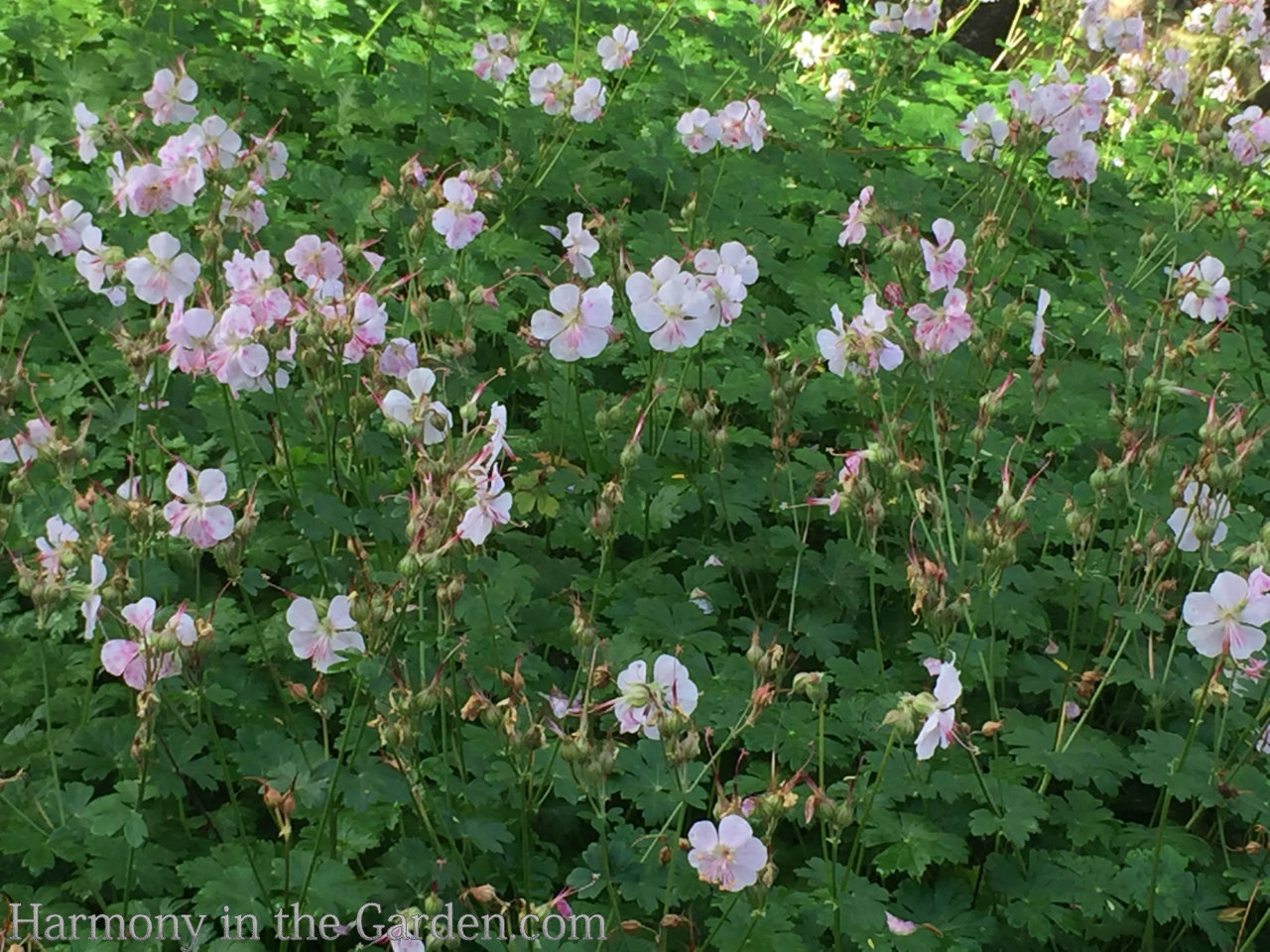
Now comes the fun part – plant selection!
I’ve grouped my favorites into 3 main categories: Bulbs, Groundcovers, and Perennials (including grasses & succulents)
Generally speaking, when it comes to plant selection, I stick to those that not only have shallow root systems, but are also:
*drought-tolerant
*shade-tolerant
*tough as nails
Bulbs & Rhizomes

Spring bulbs can be a great choice to plant under deciduous trees – even those that need full sun to bloom (like daffodils, crocus, etc.)
While the tree is deciduous (without winter leaves), bulbs appreciate the sun, yet once the tree’s spring leaves appear, most bulbs are finished blooming and won’t be affected by the shade.
Plus, the small size of bulbs means they’re easier on you and the tree to physically plant around those imposing roots.
Below are a few examples that grow really well among a tree’s giant roots.
(Click here if you missed my recent article about warm-climate spring bulbs.)
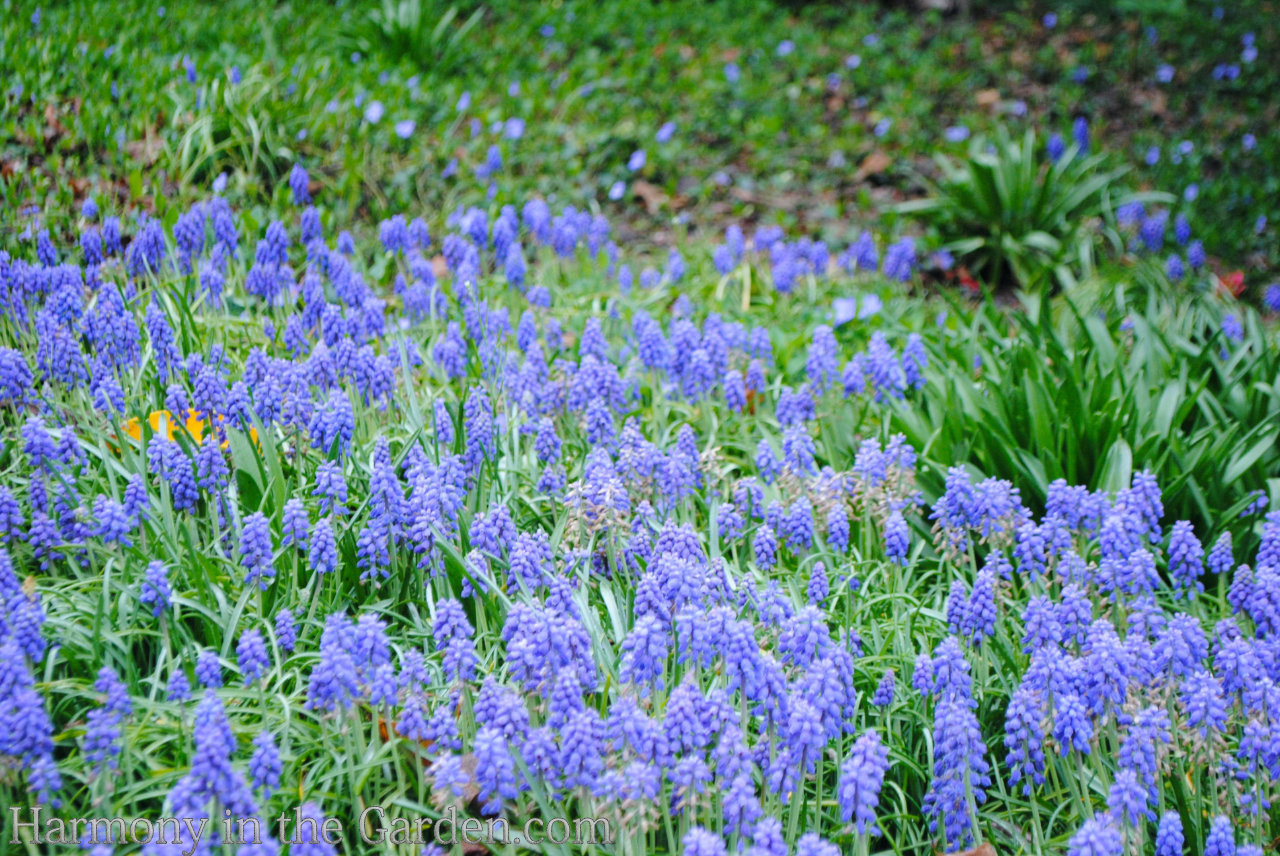
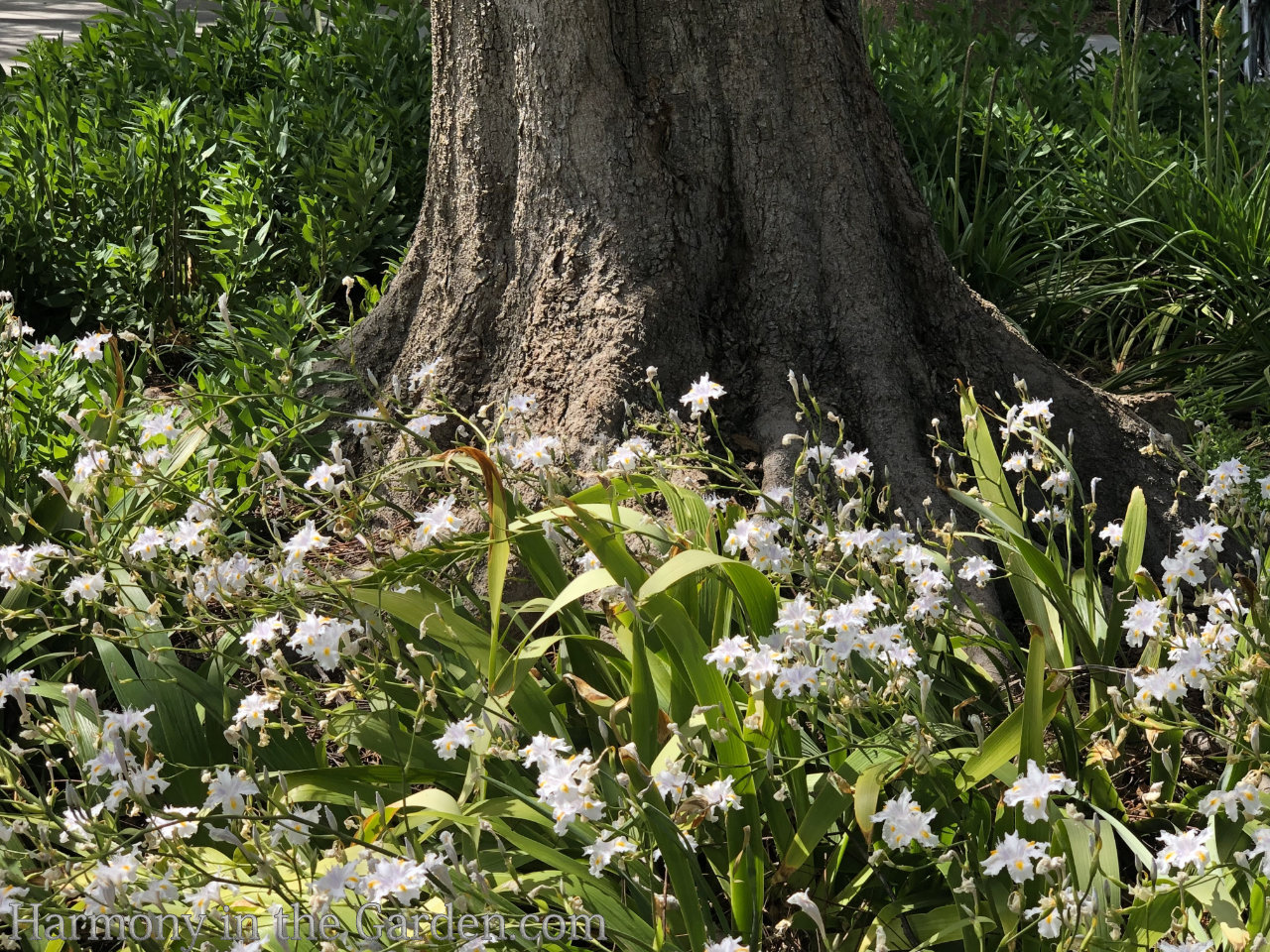
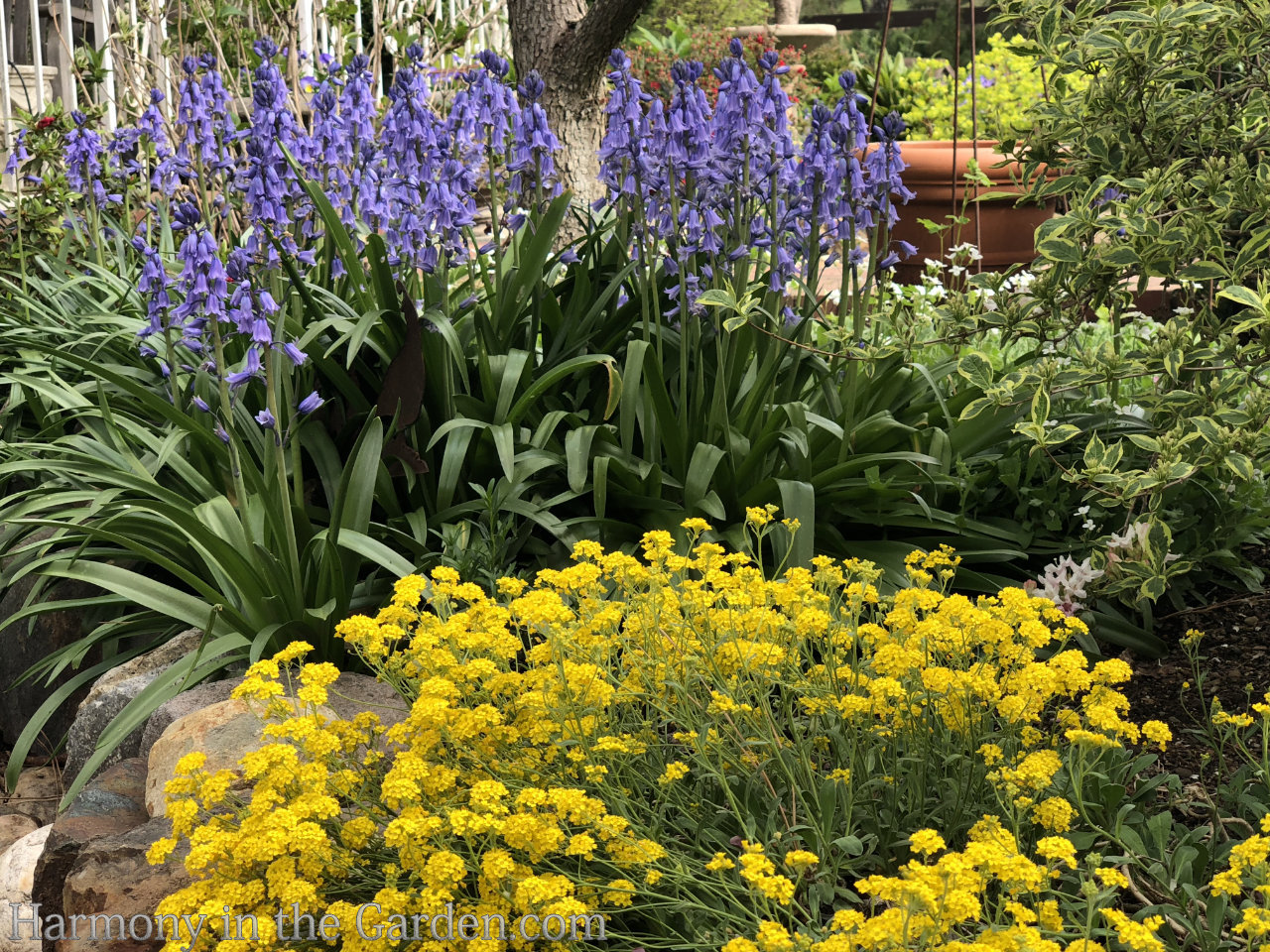
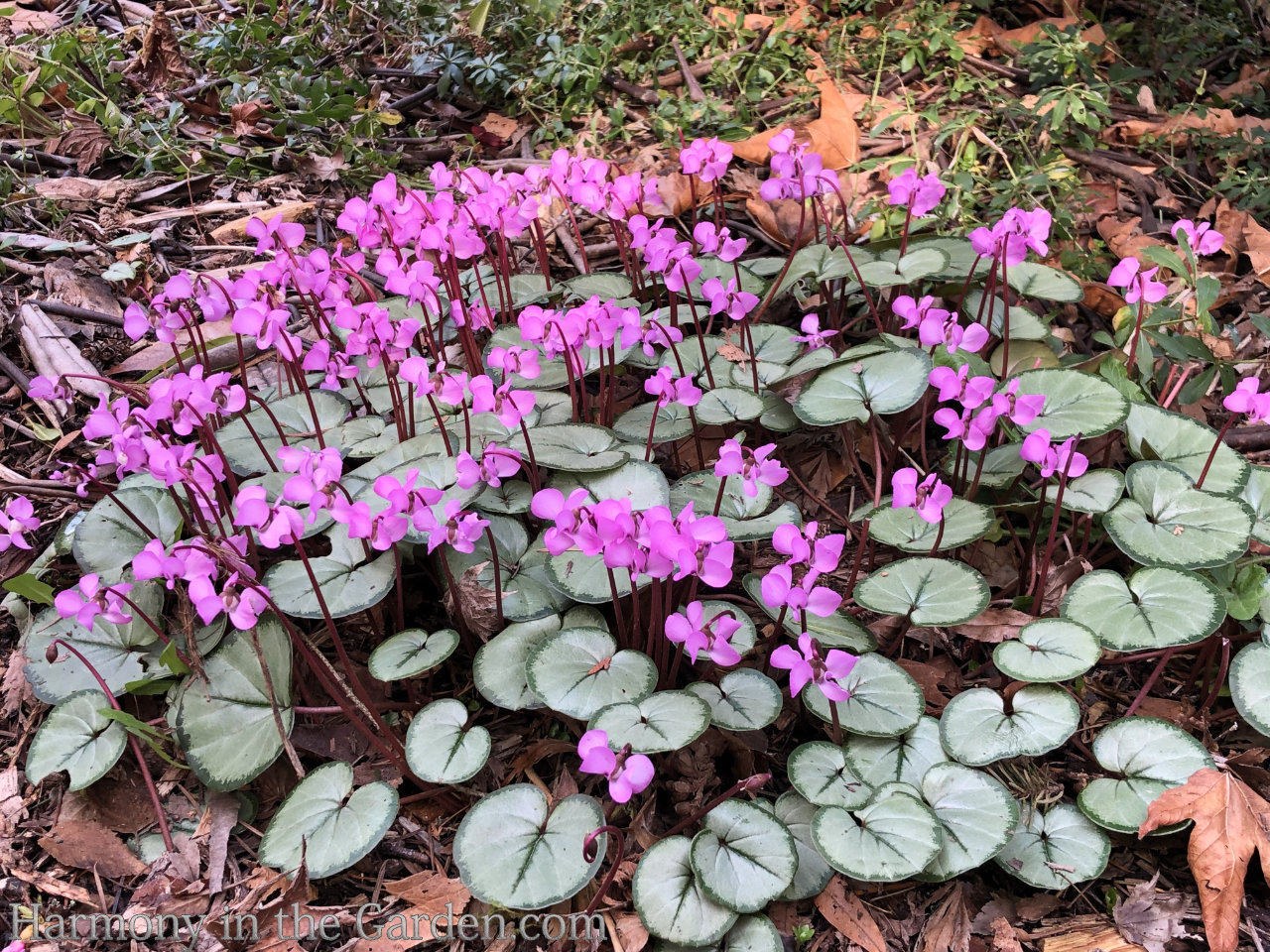
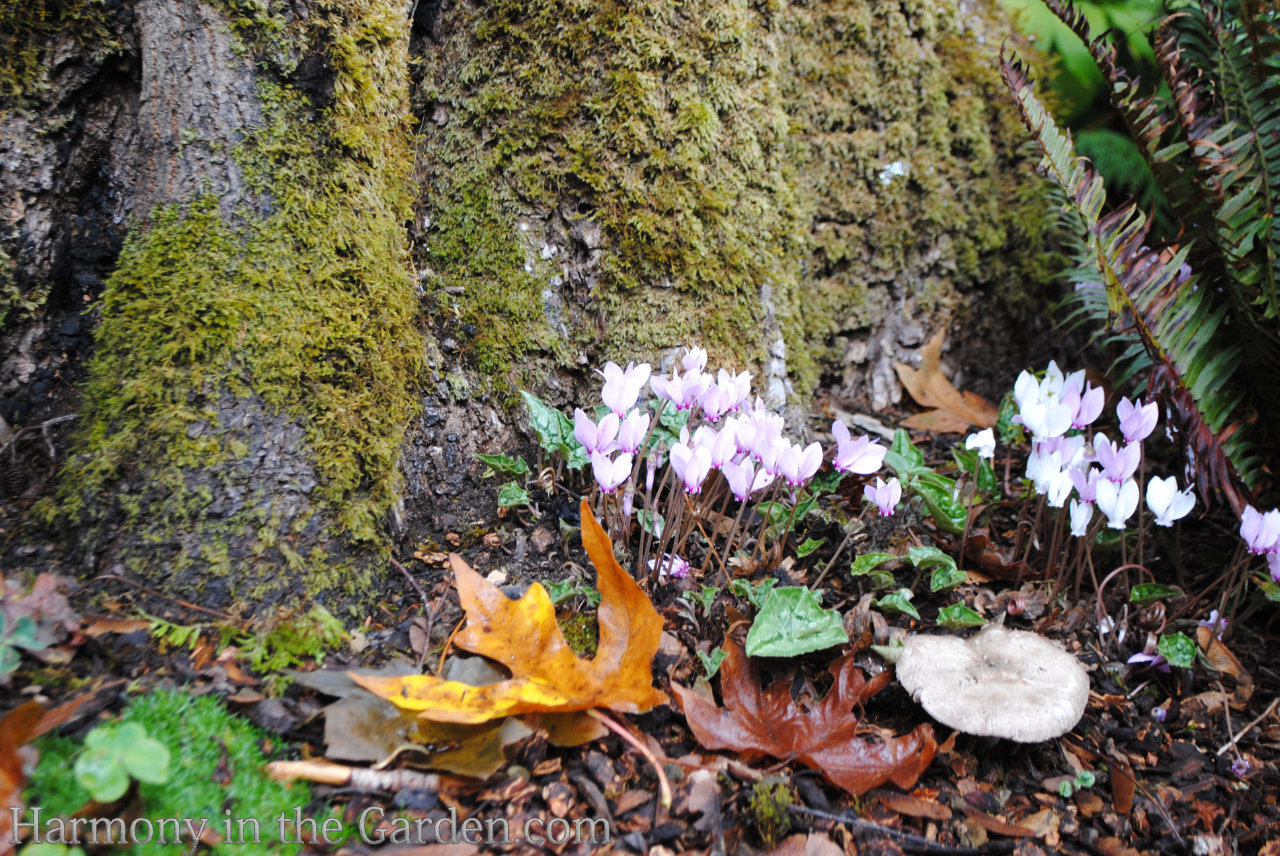
Cyclamen bulbs easily re-seed among a tree’s roots, adding much-needed late winter color. Click here for more varieties, and other late winter bloomers.
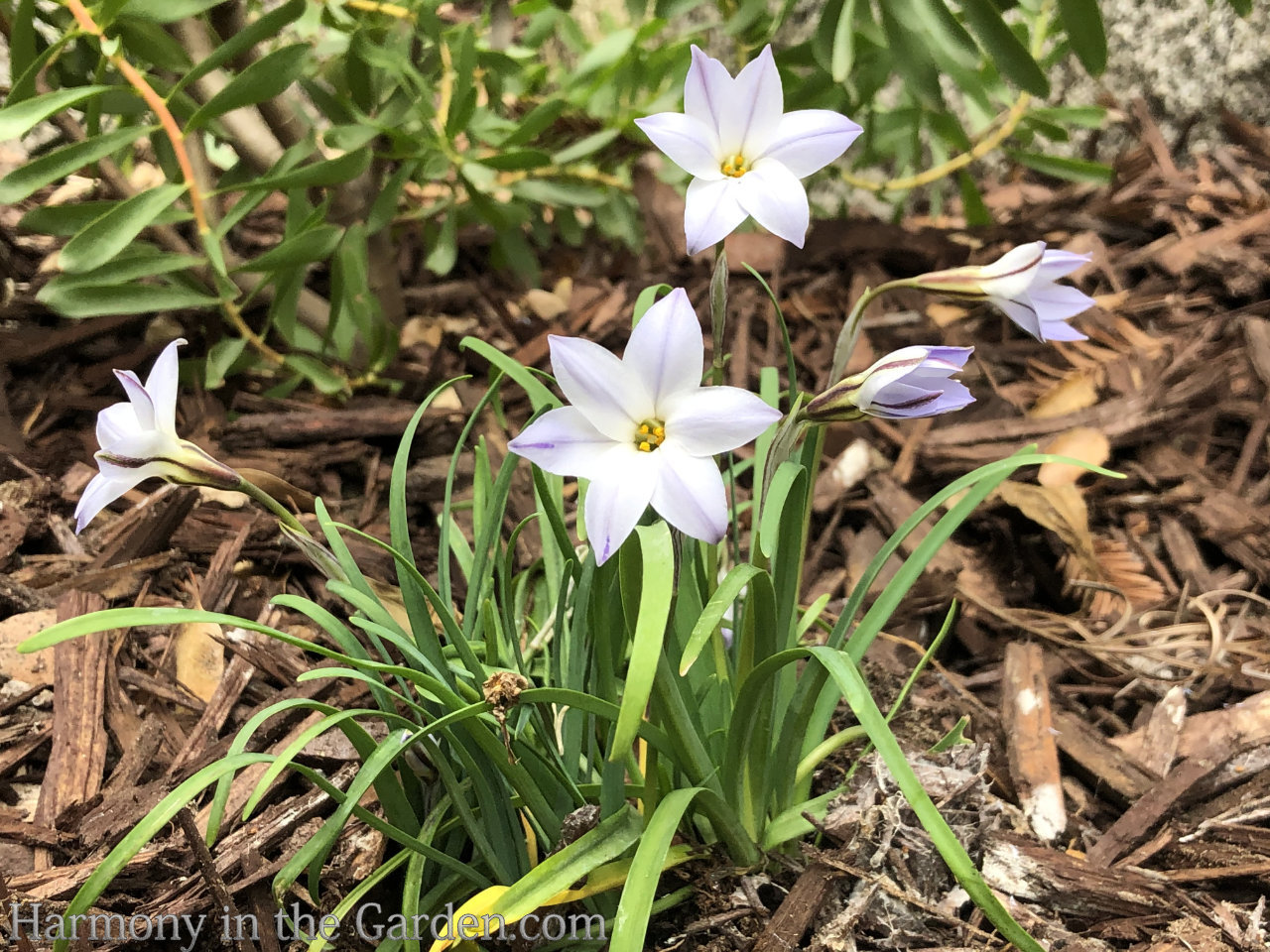

Groundcovers
Groundcovers are ideal for planting around large tree roots as they’re often available either as flats, 6-packs, or 4” pots. There’s tons of options available, but the following are just some that have shallow roots, require little water and do well in partial shade.

Geranium cantabrigiense ‘Biokovo’ is hands-down my go-to groundcover for shady, low-water areas.
This variety is evergreen in my zone-9 garden, with a heavy show of pale pink flowers in the spring and summer.
But even when not in bloom, it remains a tidy and well-behaved 24″ tall, slowly spreading mound (whereas many other varieties get leggy after time.)
It’s roots are also incredibly shallow, allowing it to easily re-root in those difficult patches near exposed tree roots.
(Click here for more of my favorite geraniums and pelargoniums.)
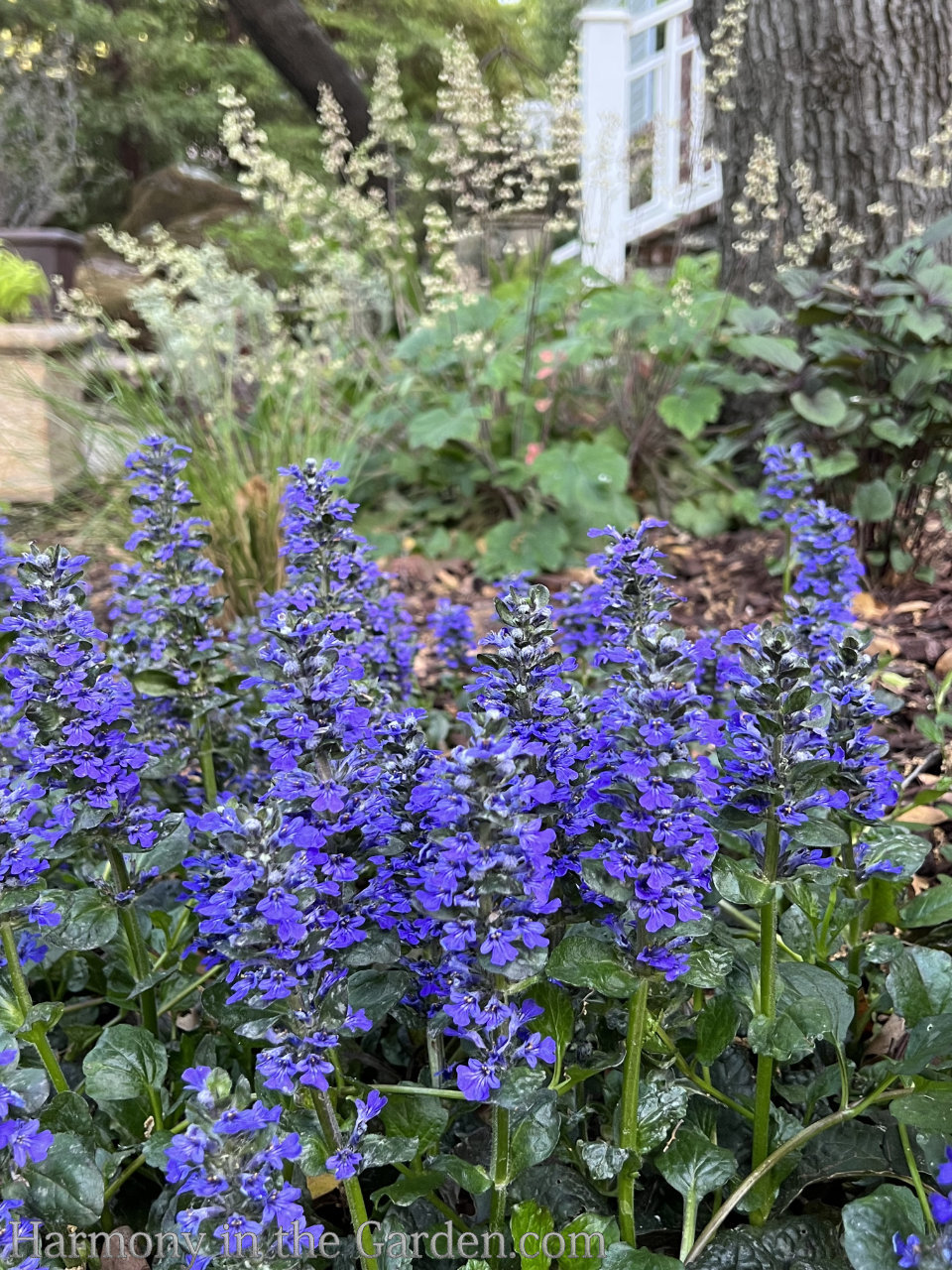
Ajuga is one of my favorite groundcovers to plant in difficult sites, such as around tree roots.
With a little added water, it quickly spreads into a dense mat. Yes, it can be invasive, but with a little yearly thinning, you can easily keep it in check.
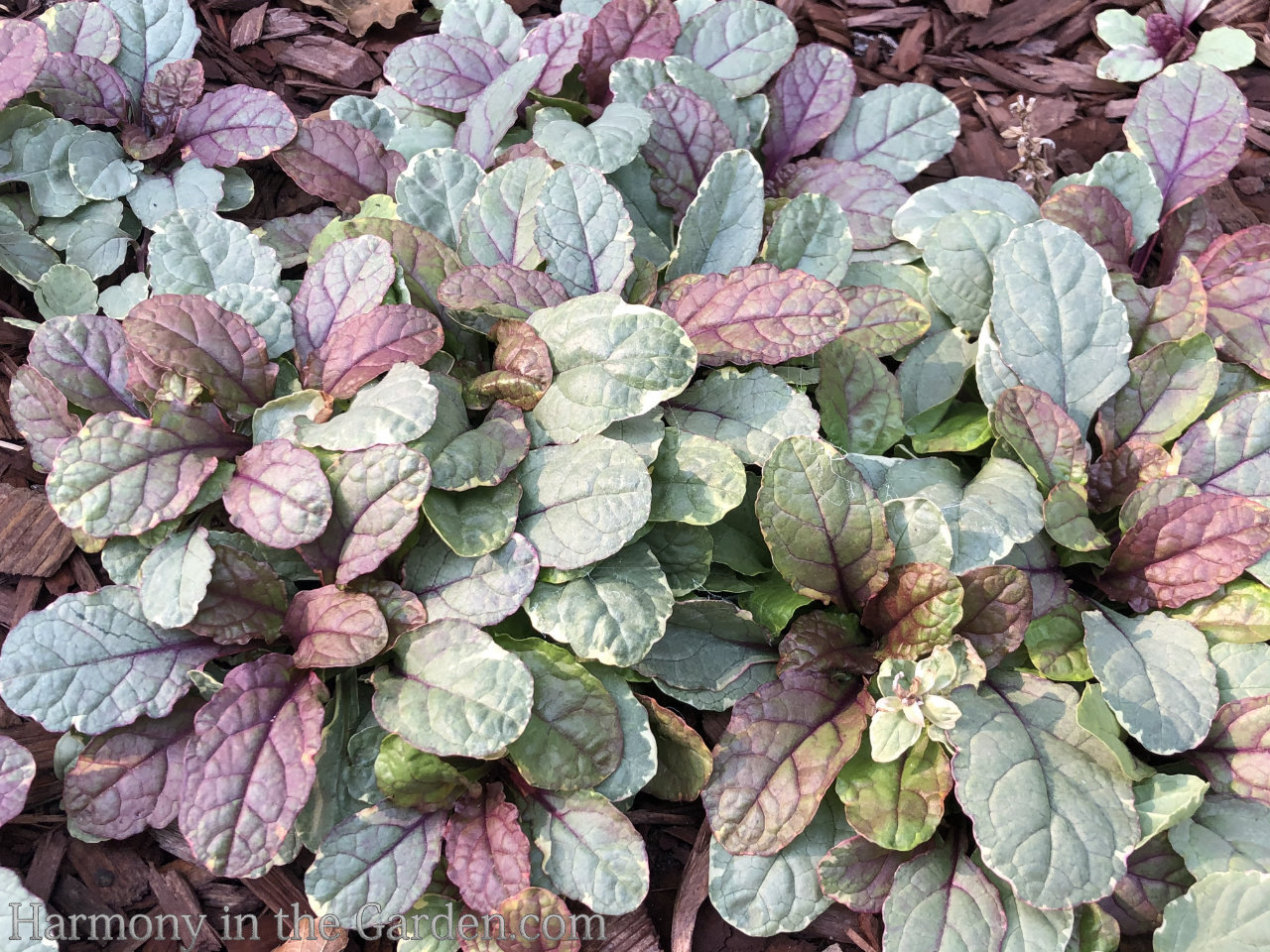
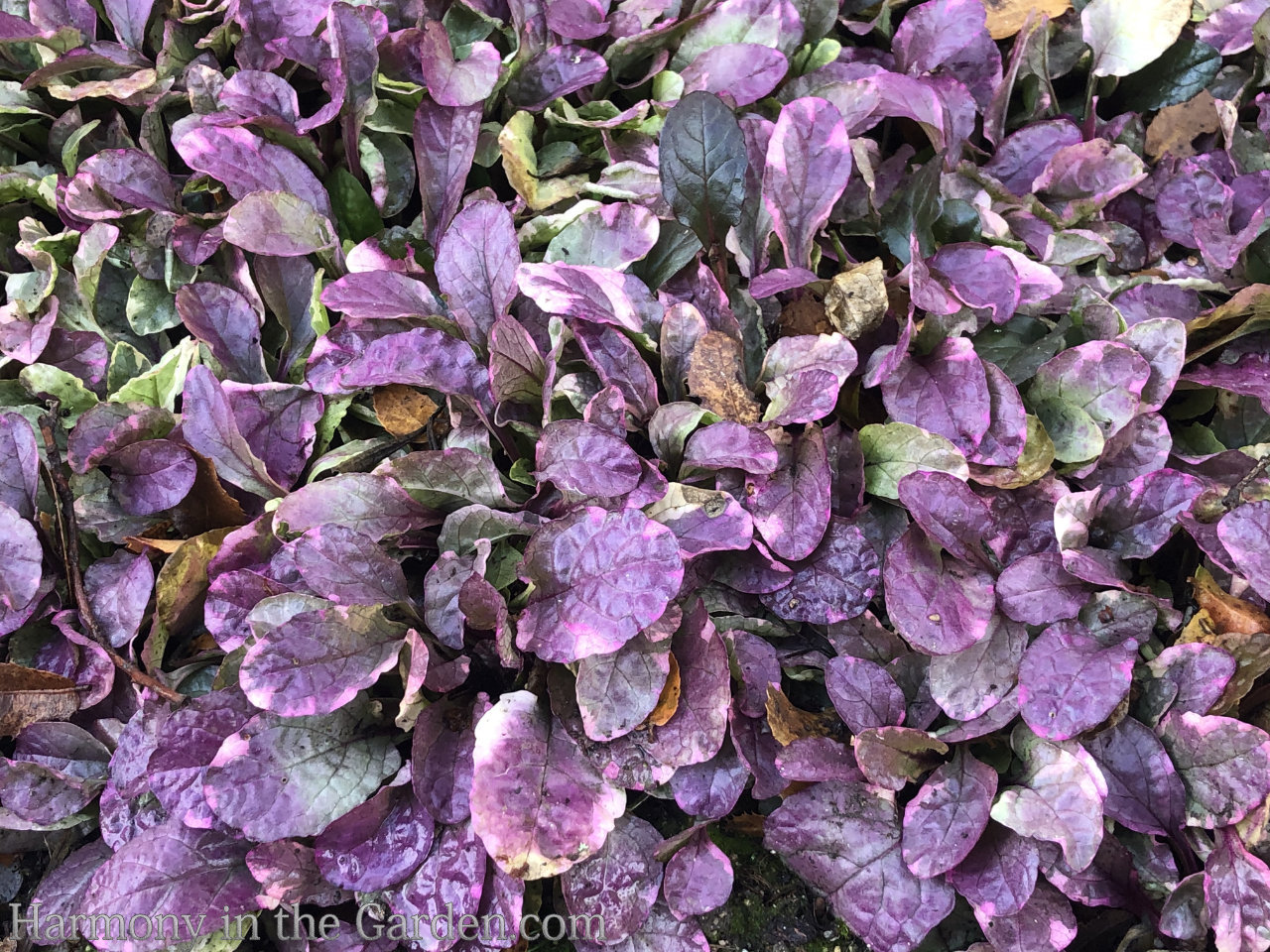
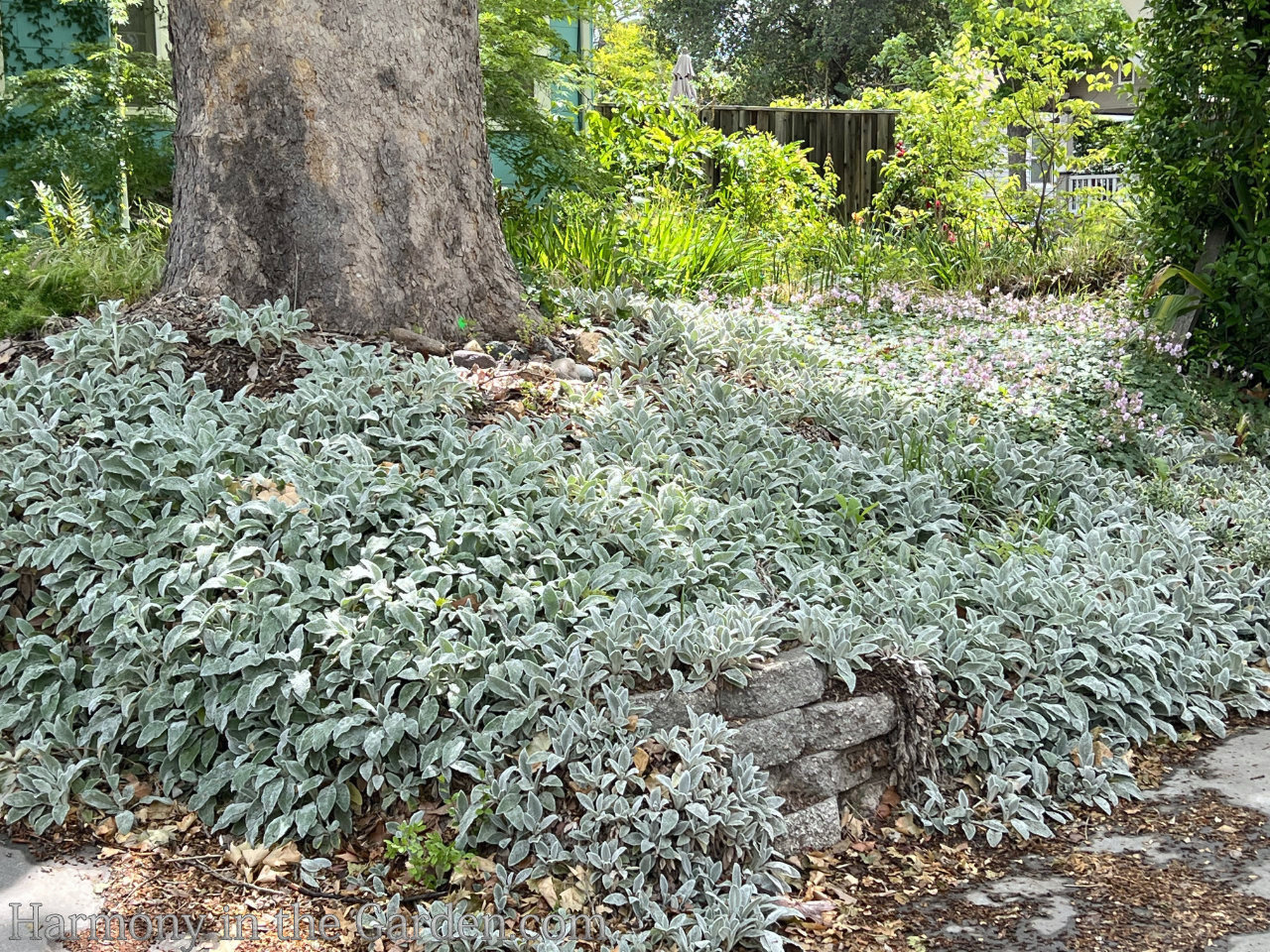
I spotted this velvety mat of lambs ears (left) in a garden with NO additional summer water, and it was just fine!
My favorite variety is ‘Primrose Heron’ (above) which spreads less and has unusual yellow-green spring foliage. Both varieties do well in part shade.
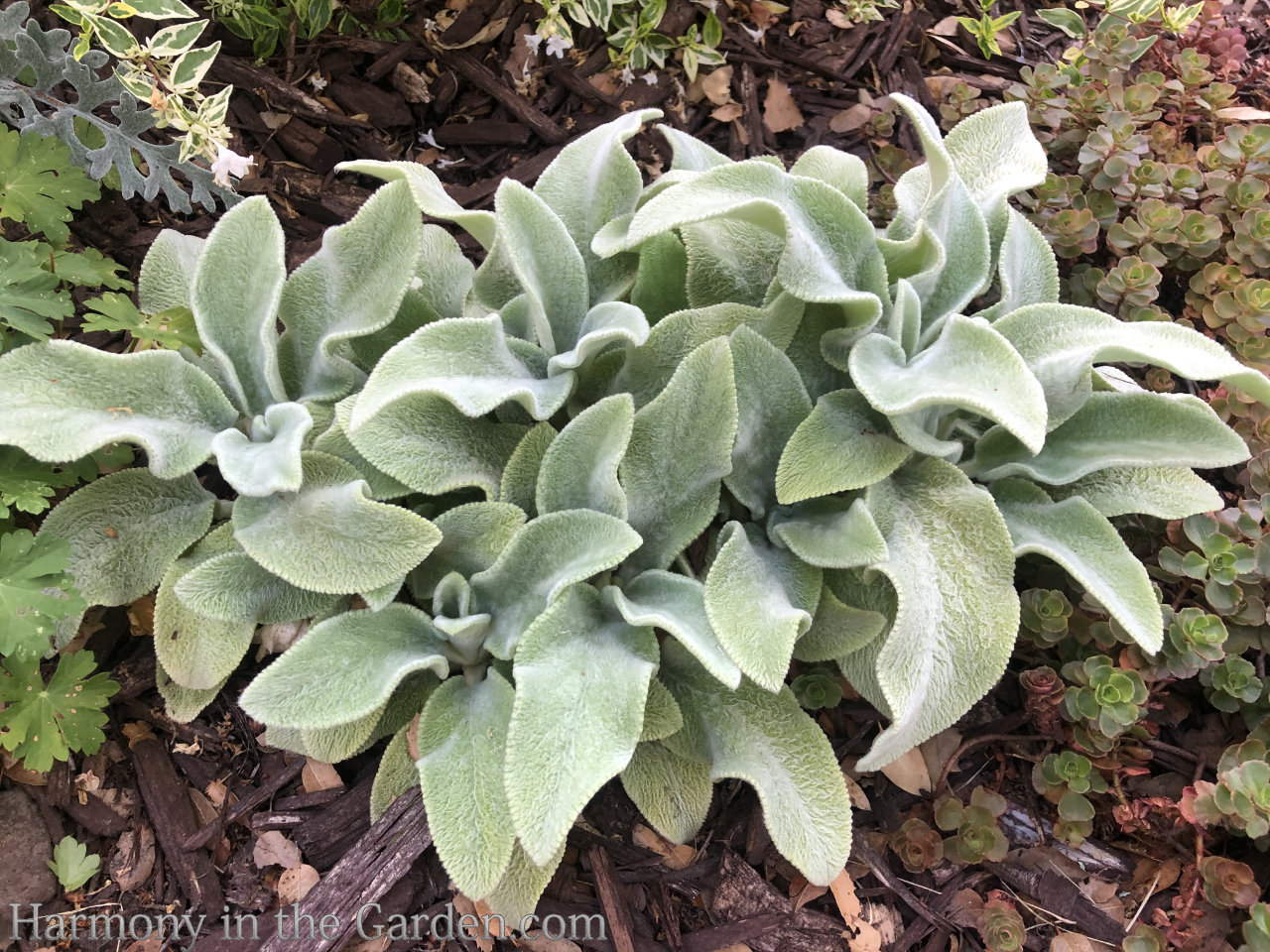
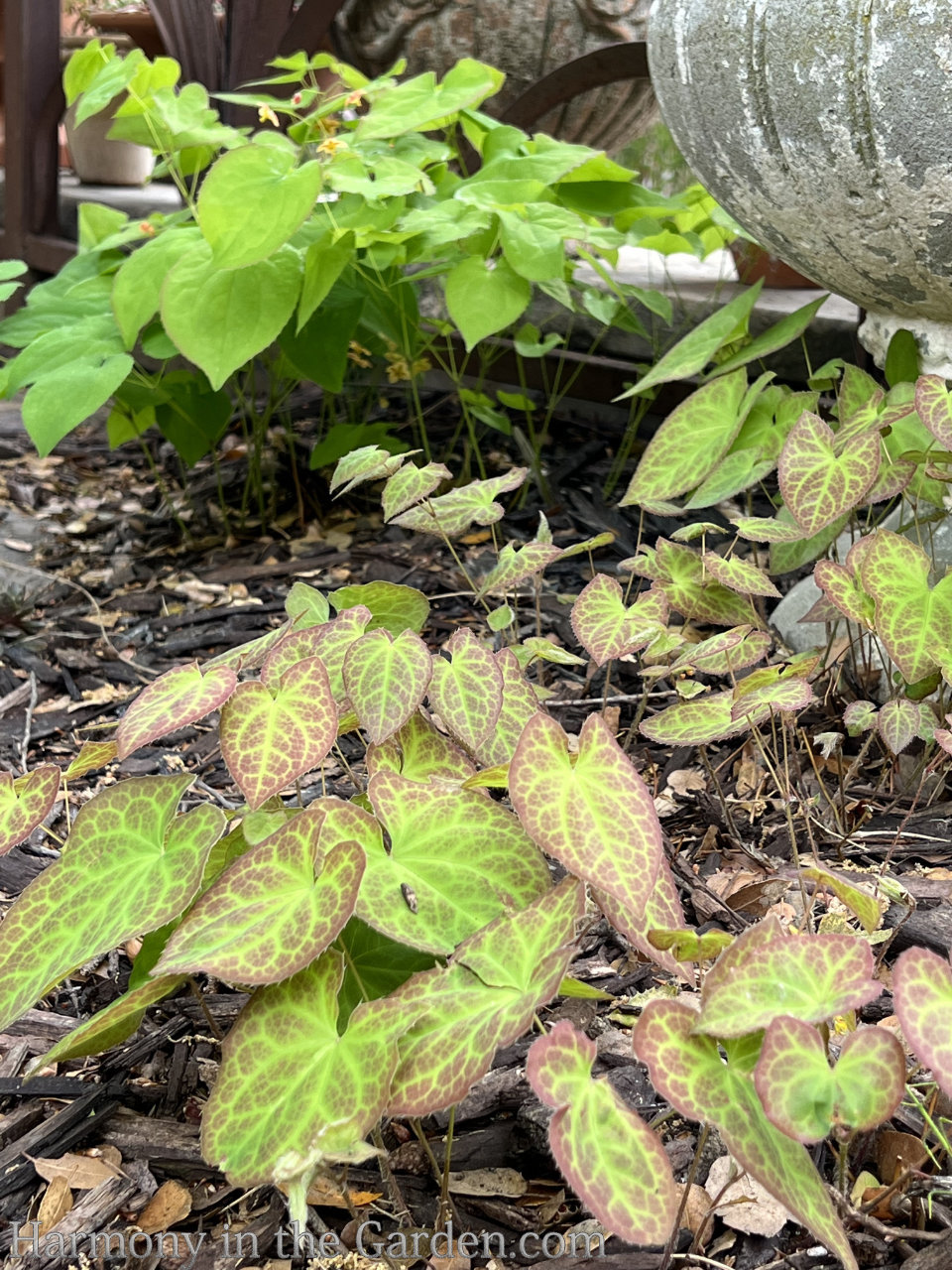
Epimediums (Barrenworts) are excellent groundcovers, slowly spreading in dry, shady sites. They have the sweetest little flowers, too!
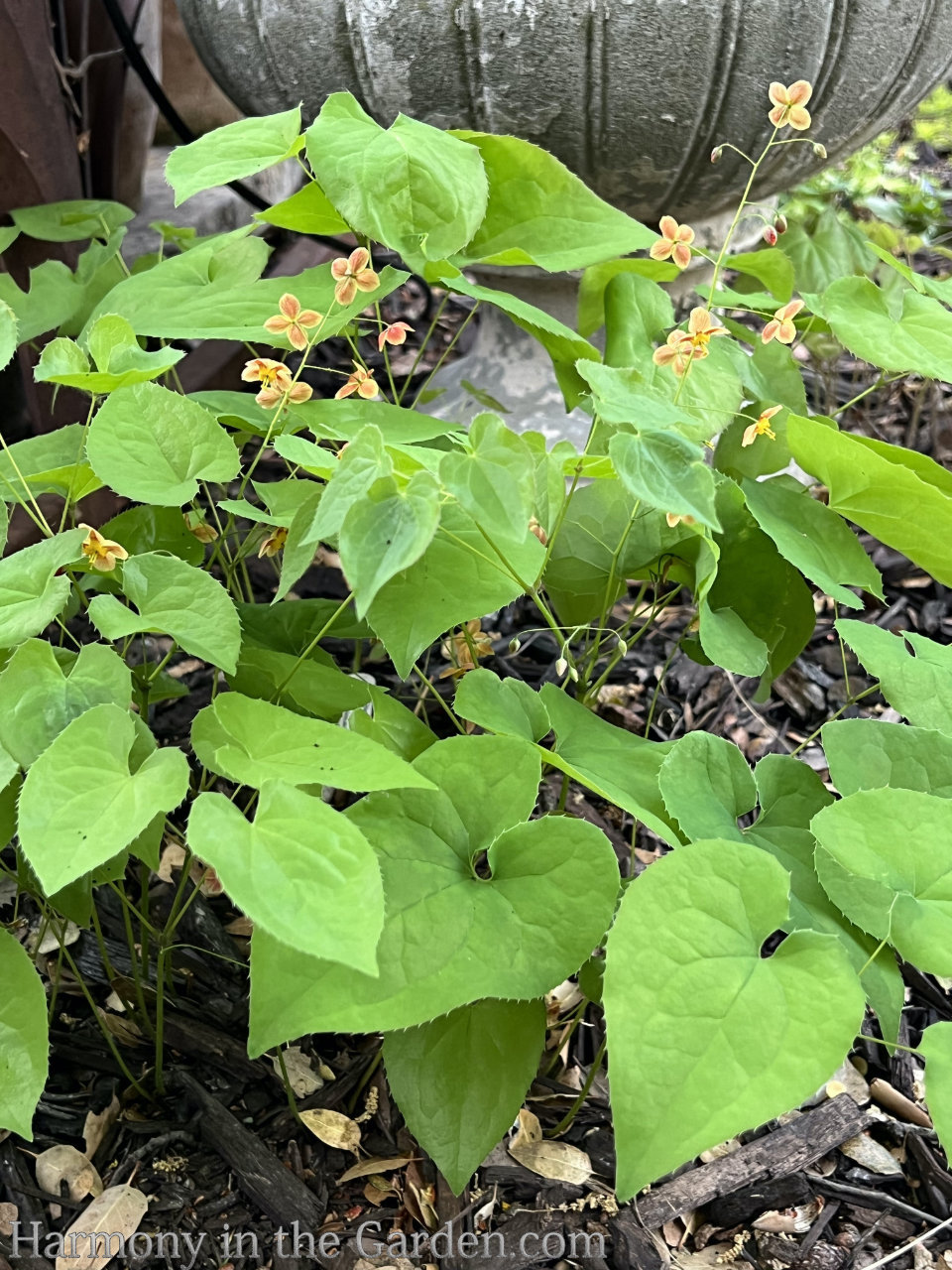

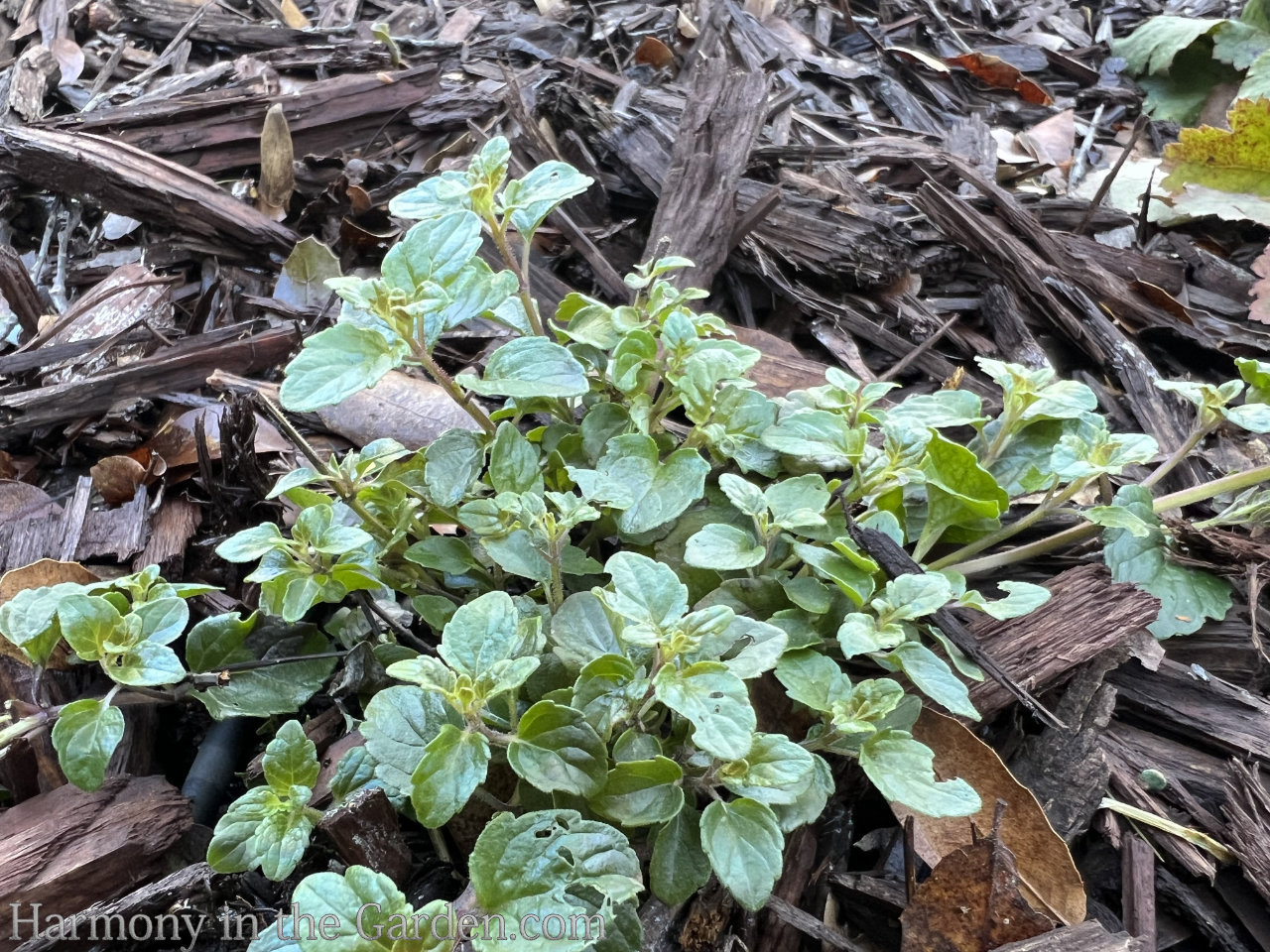
Satureja douglasii ‘Yerba Buena’ (left) is an amazing little groundcover. Shallow roots, low-water once established, quickly spreading to 2″ x 6′ wide, and smells like mint!
I use it throughout my garden in any shady spot where I want a lush patch of evergreen, and when given afternoon shade, it’s happy as can be.
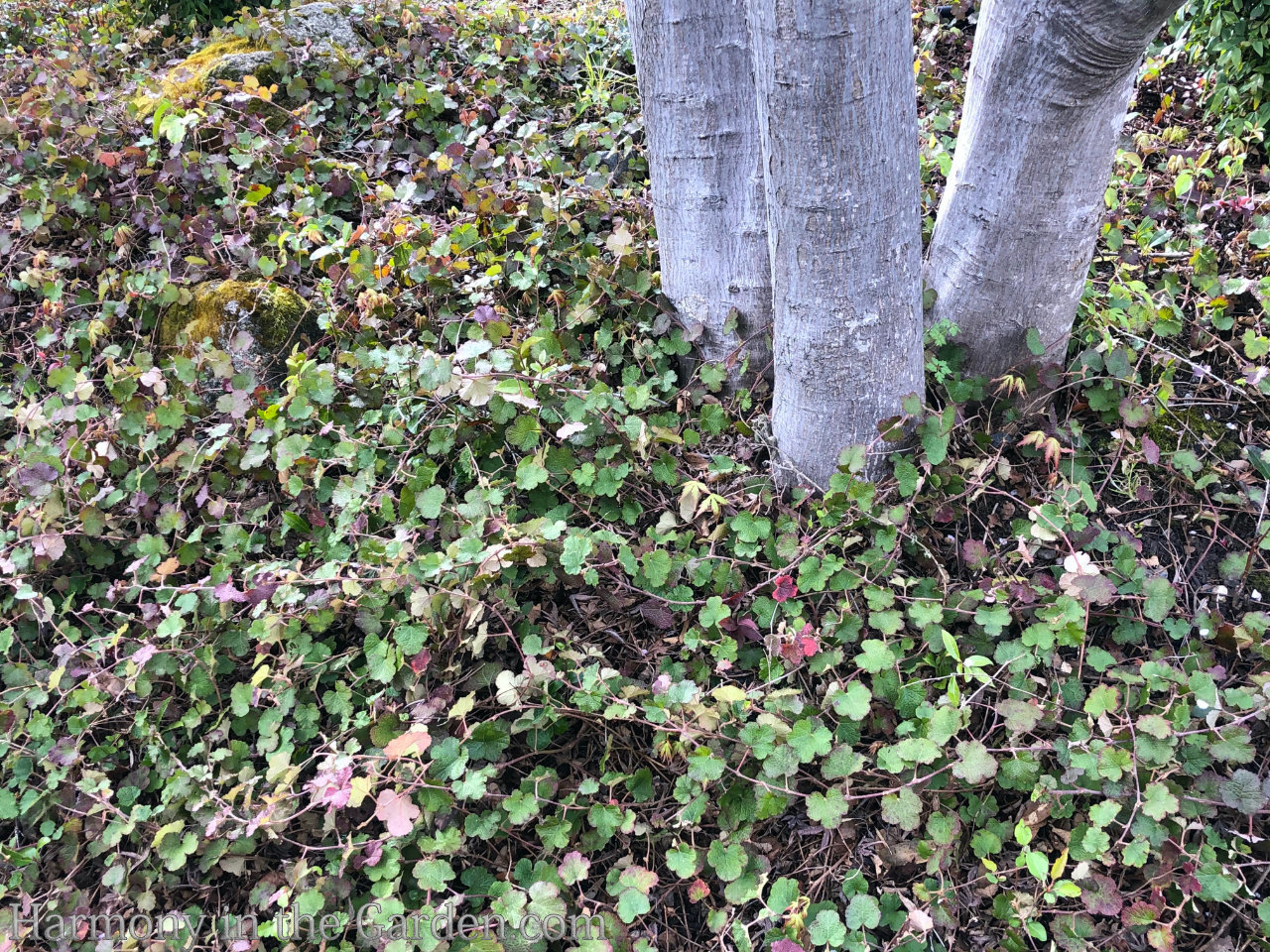
Rubus pentabulous (Creeping Raspberry) is another deer-resistant, low-growing groundcover perfect for under trees.
It needs a little summer water to do well, and has slightly prickly stems that re-root along the ground to 4-feet or more.
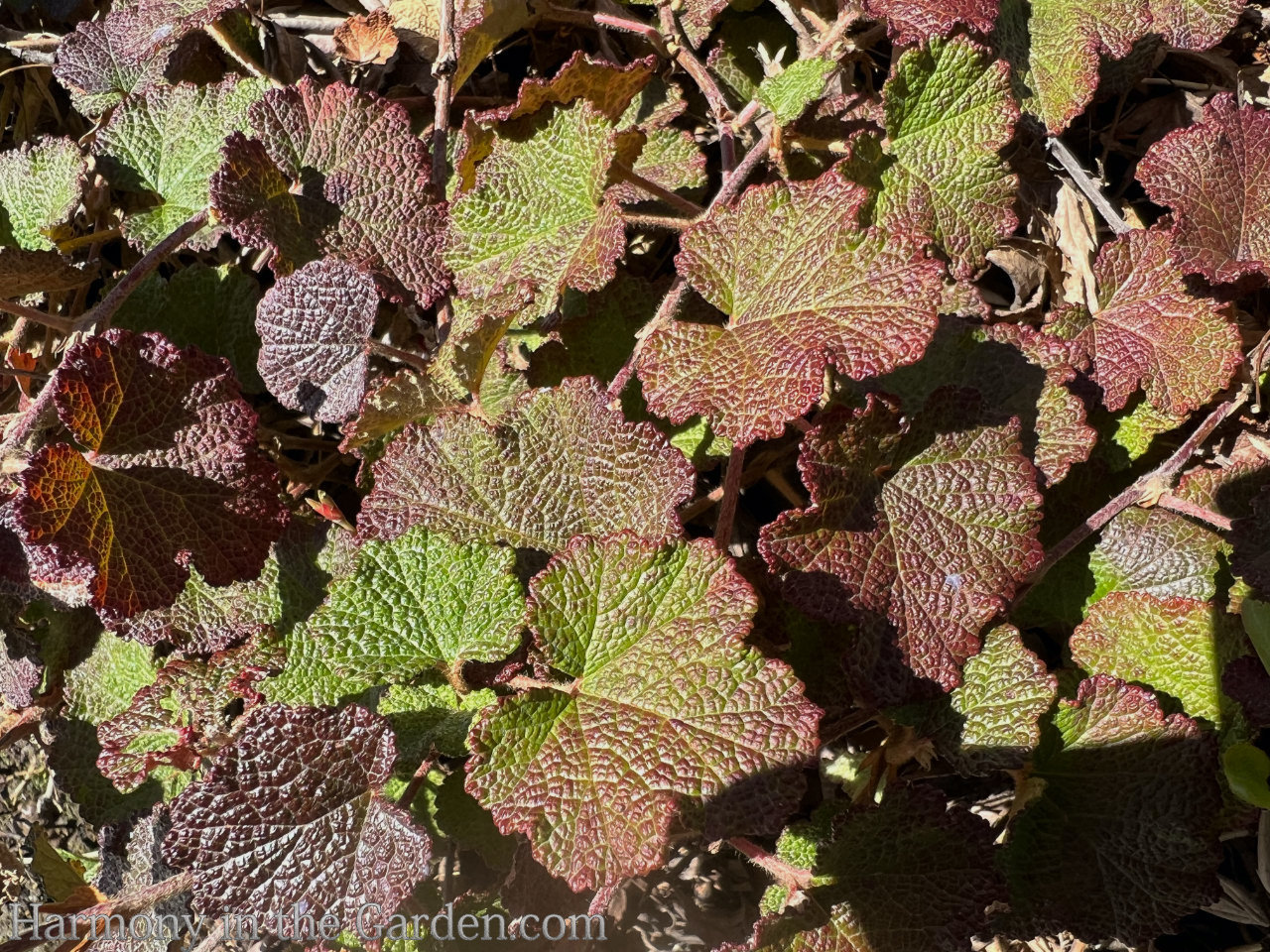
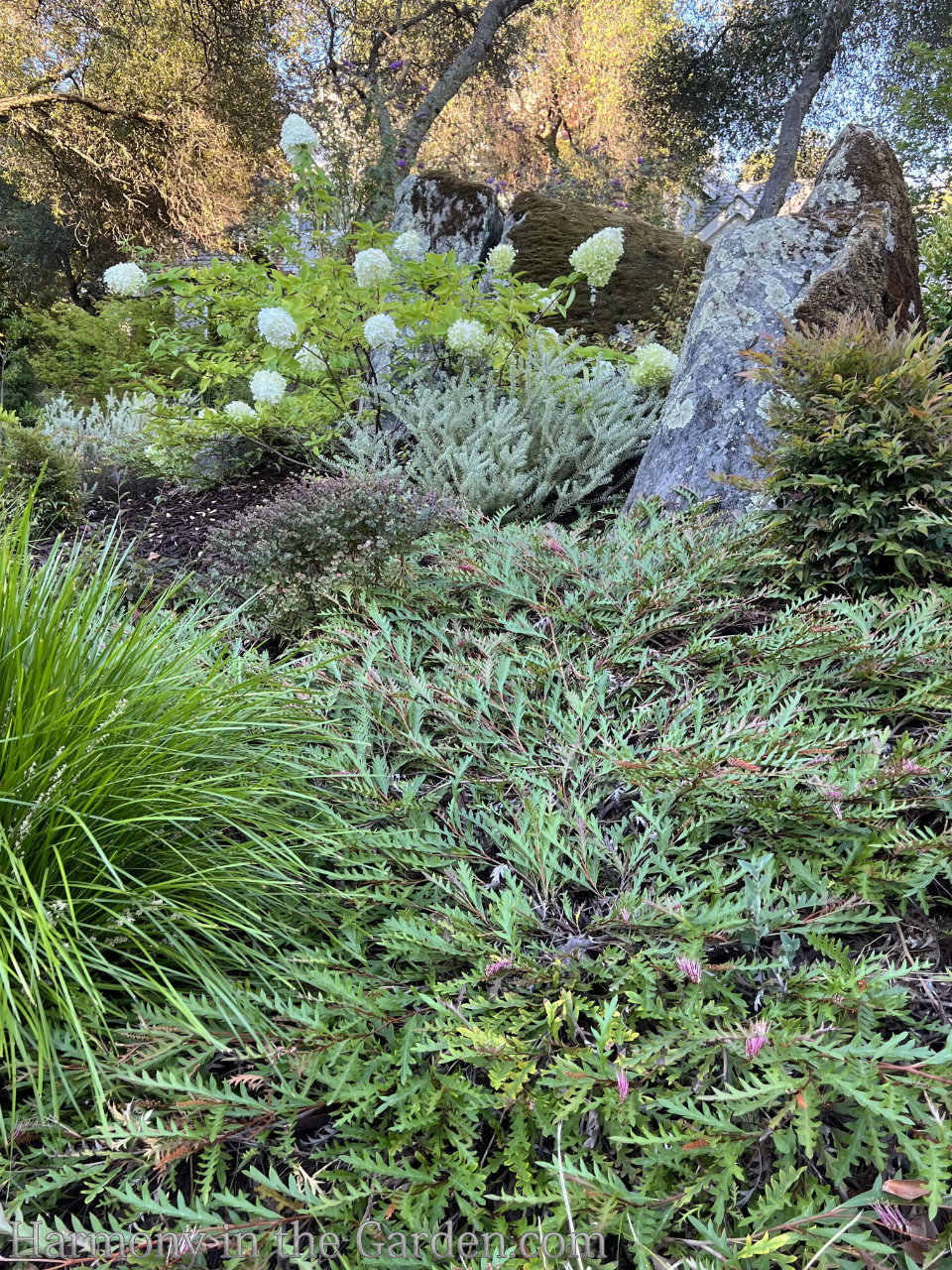
Hear me out on this one!
I’ve included grevillea ‘Fanfare’ in the groundcover section because even though it’s typically available in 1-gallon sizes, it’s still fantastic for planting under trees.
The reason is simple: because it spreads to 10-feet (or more!), it can be planted farther away from the tree’s drip line and allowed to spread.
I’ve found it also does really well with part-shade, with no reduction in flowers.
Oh, did I mention the deer never touch it, it’s super low-water, and the hummingbirds go crazy for it?

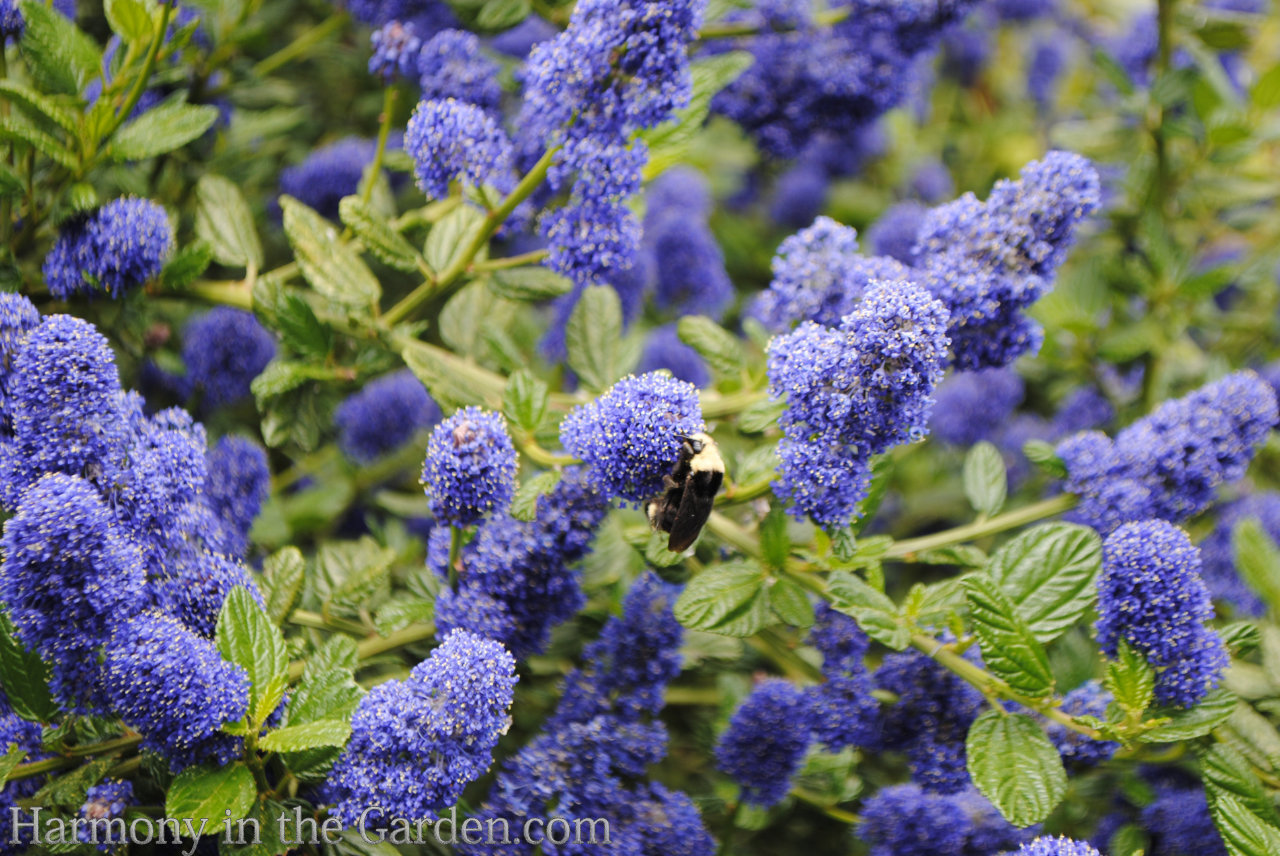
Similar to the grevillea (above), ceanothus is another example of planting a 1-gallon plant farther from the tree trunk and letting it spread to fill the space under the tree.
There are several low-growing varieties, such as ‘Centennial’ or ‘Carmel Creeper’, and all are loved by pollinators and hummingbirds.
Perennials, Grasses and Succulents
Many of the perennials, grasses and succulents below are available in flats, plugs, 4” pots, or are easily planted from small cuttings or transplanted seedlings.
If you’re having problems finding them in 4” pots, try asking your local nursery if they can request some from their grower (I’ve had great luck with this.)
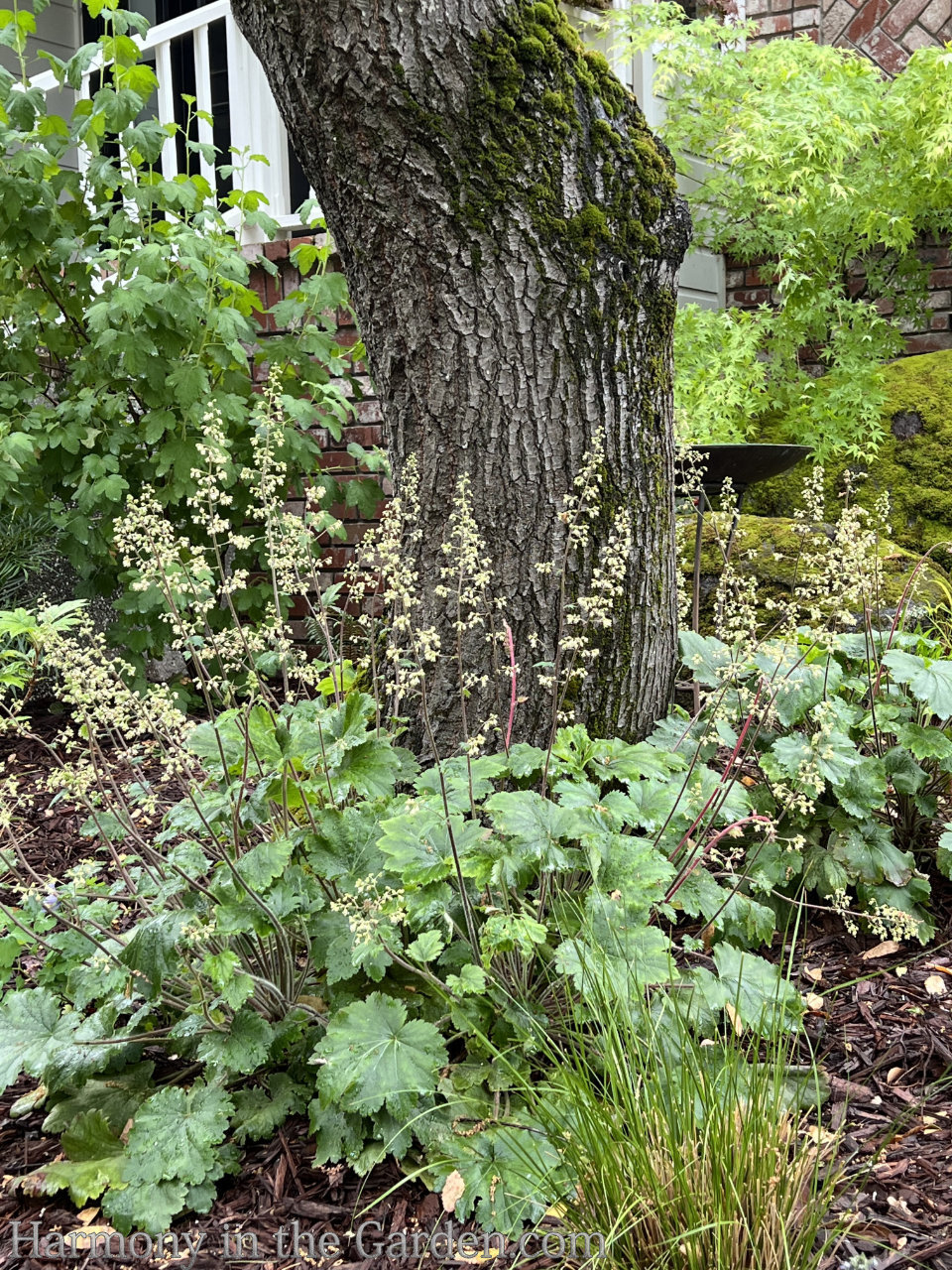
Heuchera maxima (left) is another go-to perennial to plant among tree roots. It’s often available in 4″ pots and is easy to start from small cuttings.
It’s much larger than other heuchera varieties, growing to 18″ x 18″, with tall wands of white flowers lasting for weeks.
If you have a bit more water to offer, tiarellas (below) are also perfect for tree roots for the same reasons.
Tiarellas are a bit smaller (12″ x 12″), but many have striking foliage with cute little spires of flowers.
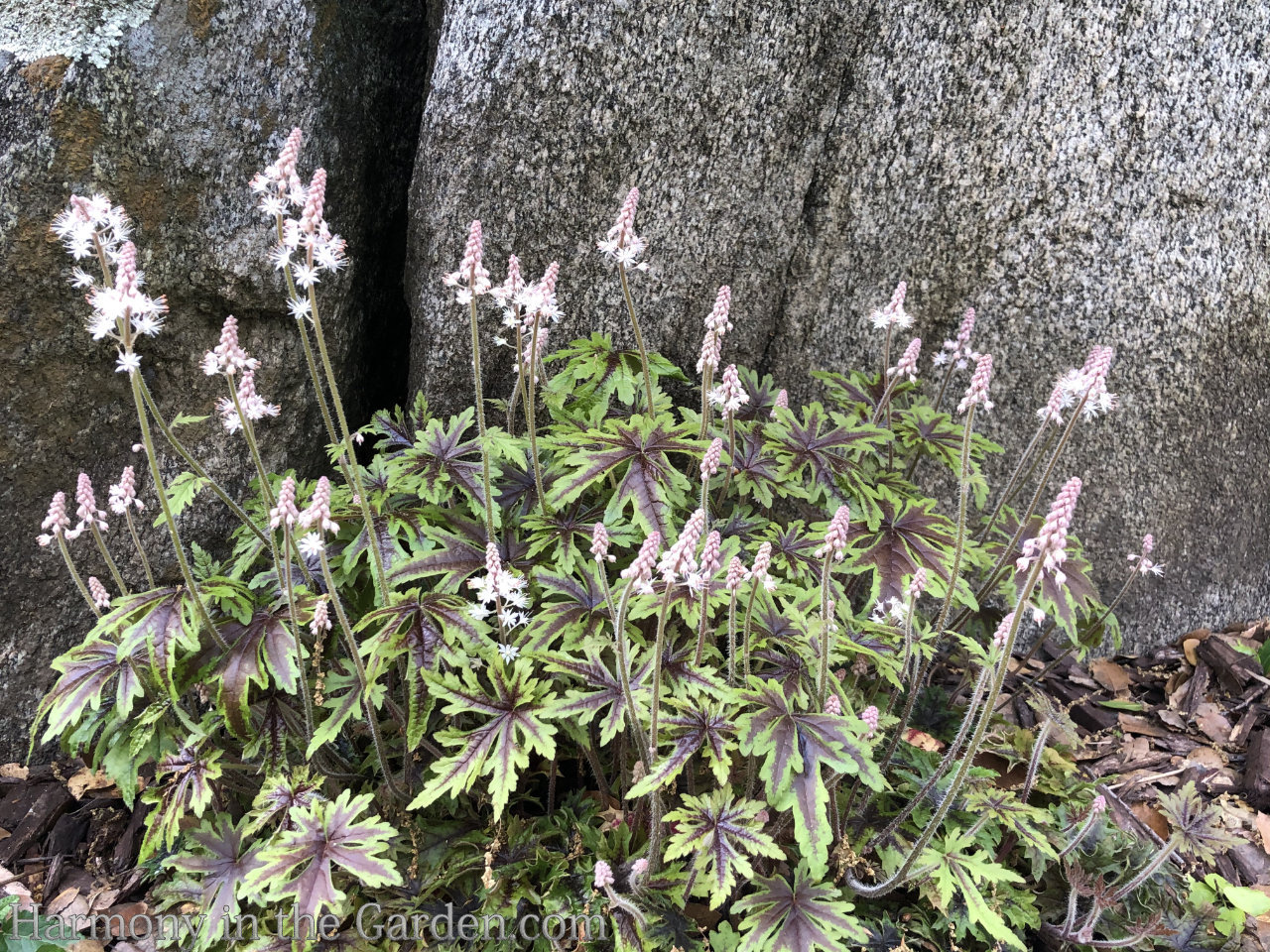

Centranthus (Jupiter’s Beard) is usually found in 1-gallon containers, which means you should plant it outside the tree’s drip line.
However, when happy, the centranthus will gladly re-seed itself around the tree (as in this photo), meaning you get the flowers without digging and damaging the tree roots!
Whether you use the white-flowered variety like this one, or the more common red-flowered one, both are low-water and tough as nails.

Bergenias are another super tough, low-water perennial that are typically only available in 1-gallon sizes.
However, because they quickly multiply and transplant so easily from cuttings, they’re ideal for tucking here and there among tree roots.
And even when not in bloom, the oversized, evergreen foliage is beautiful on its own.
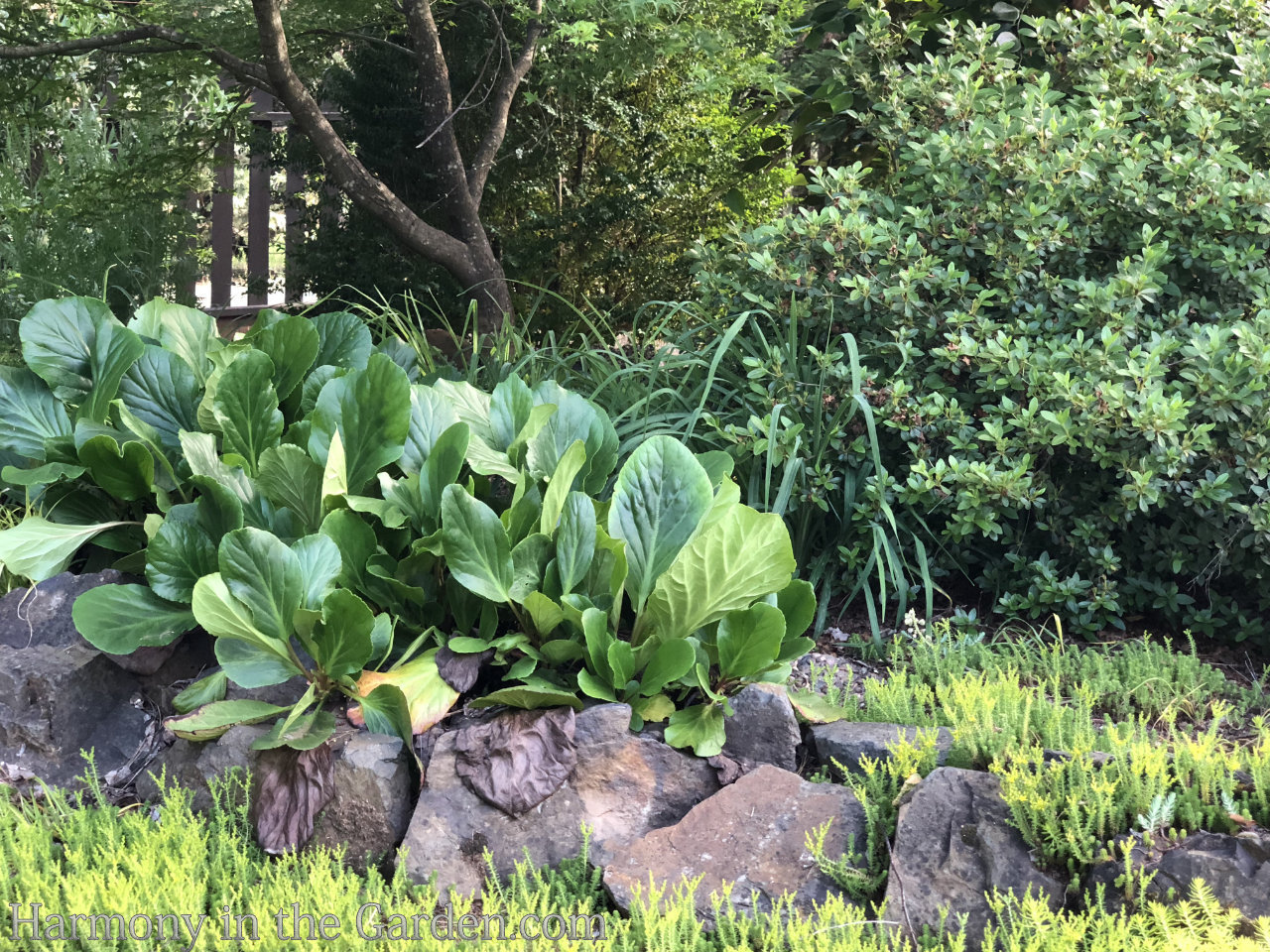
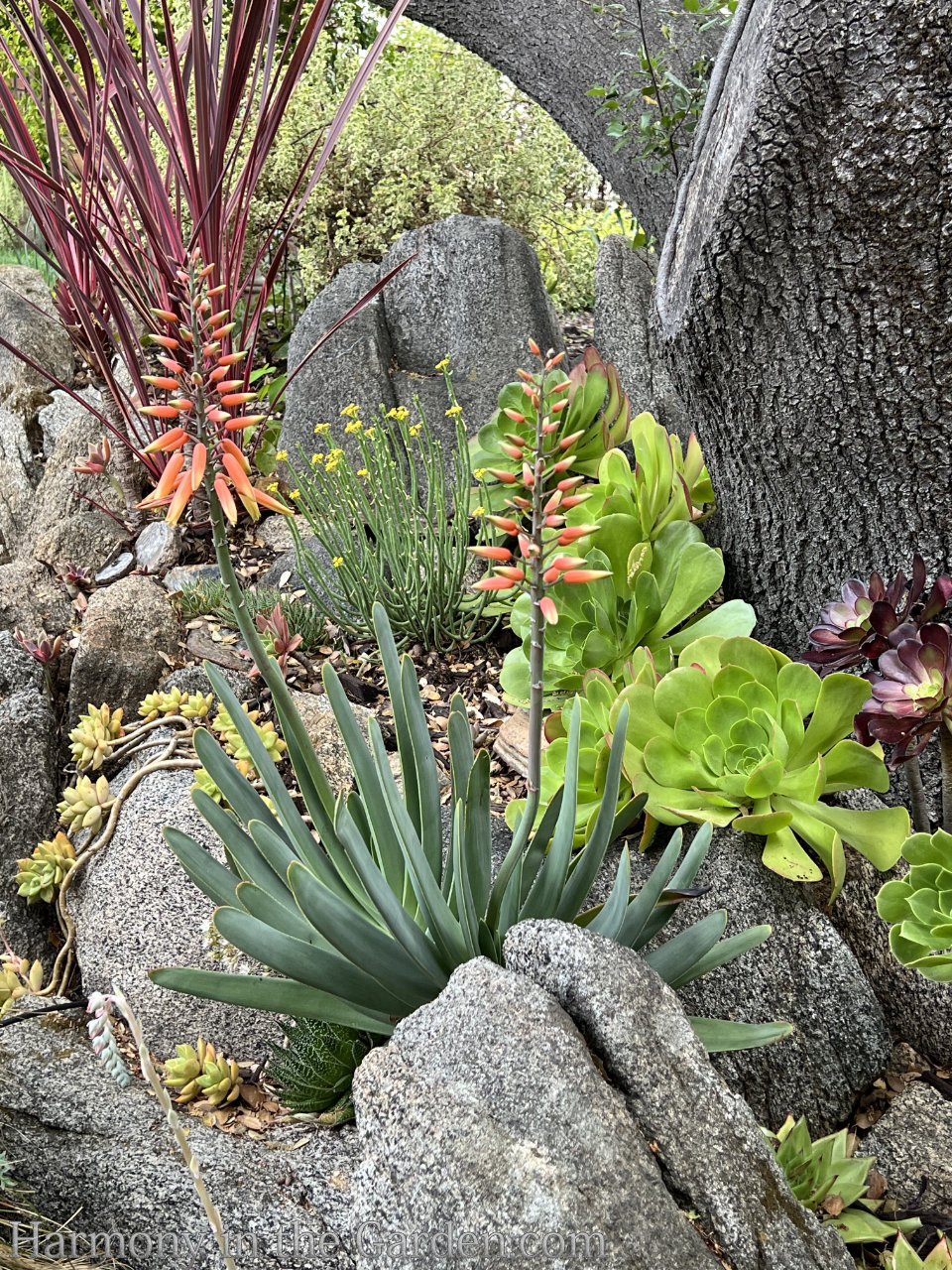
I have oak trees throughout my garden which, as you may know, are very sensitive to having their roots disturbed.
Succulents are fantastic for planting among the tree roots, as they have shallow roots, are very low-water, and appreciate partial shade.
If you’d like to read about the other plants that live in the dry shade under oaks, click here.
And for more about succulents, and those that are cold-hardy (yes, they do exist!), click here.
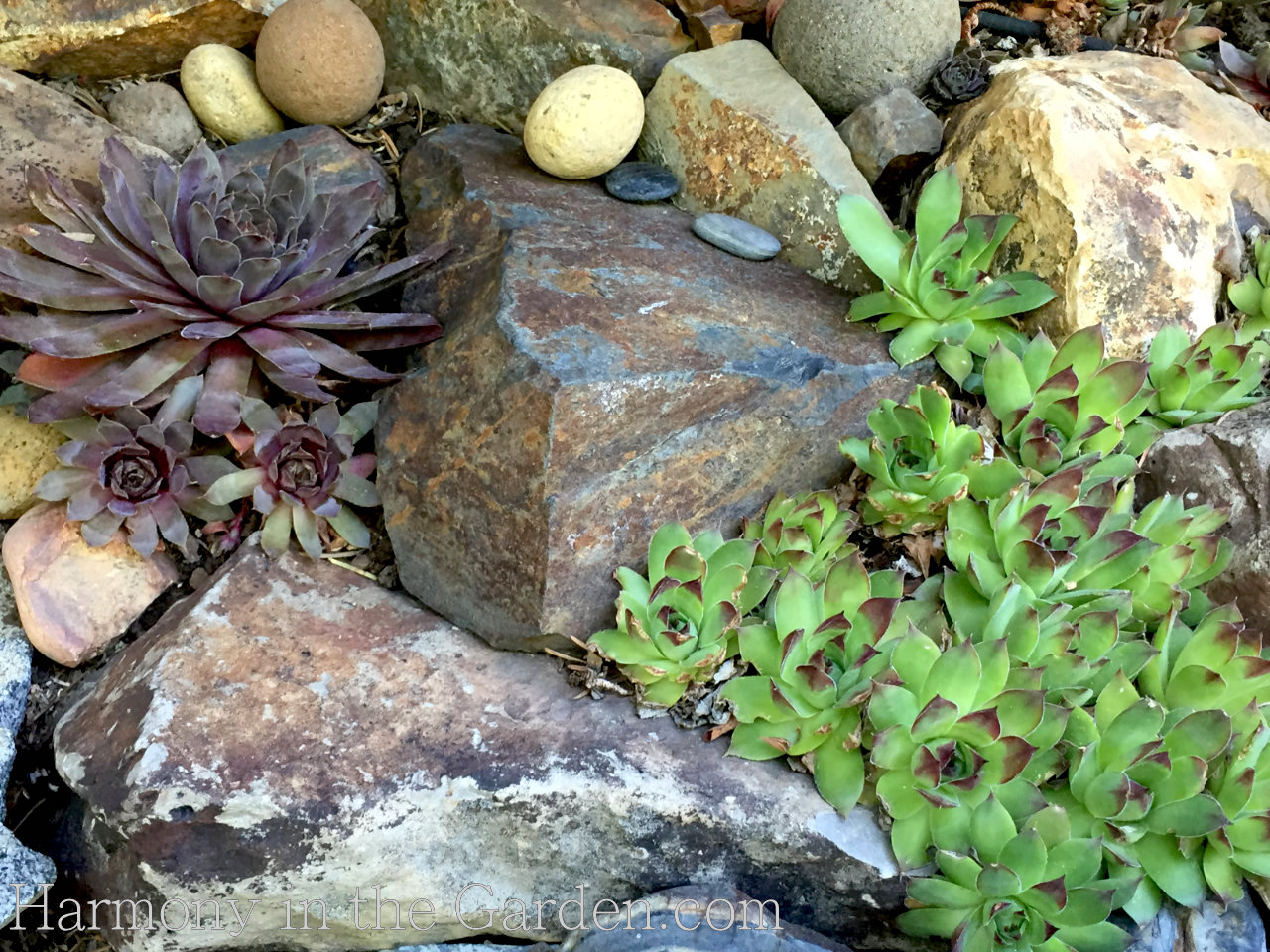

Recently I was in Petaluma where I spotted these fantastic aeoniums planted at the base of these massive trees.
While they spill over onto the sidewalk just a bit too much, I can’t imagine a pedestrian complaining! 😉

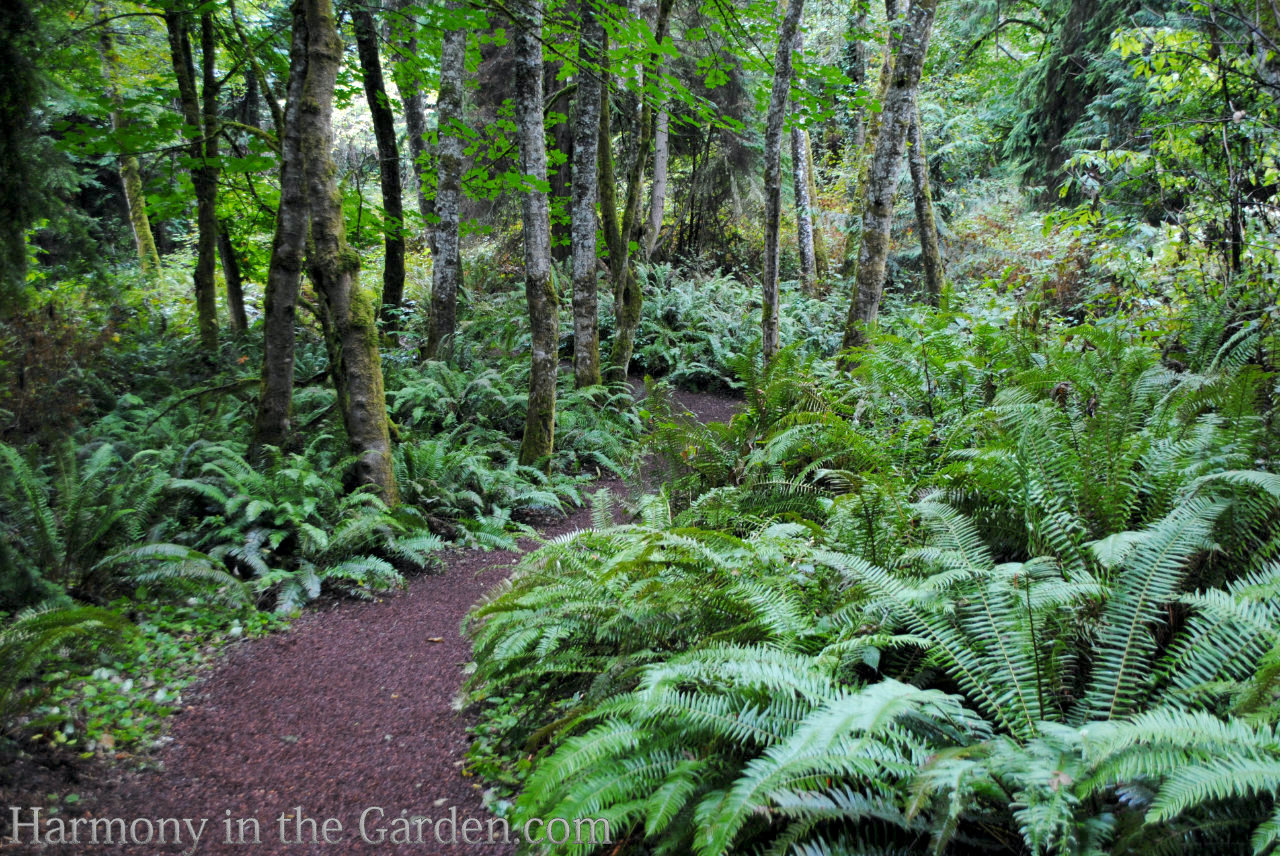
Many ferns do wonderfully well planted under trees, thanks to their shallow roots.
Alas, it’s too hot and dry in my climate to plant most varieties.
There are a few exceptions that do well in my hot and dry garden, which are the Western Sword fern (polystichum munitum, left) and the Japanese Holly fern (crytomium falcatum ‘Rochfordianum’).
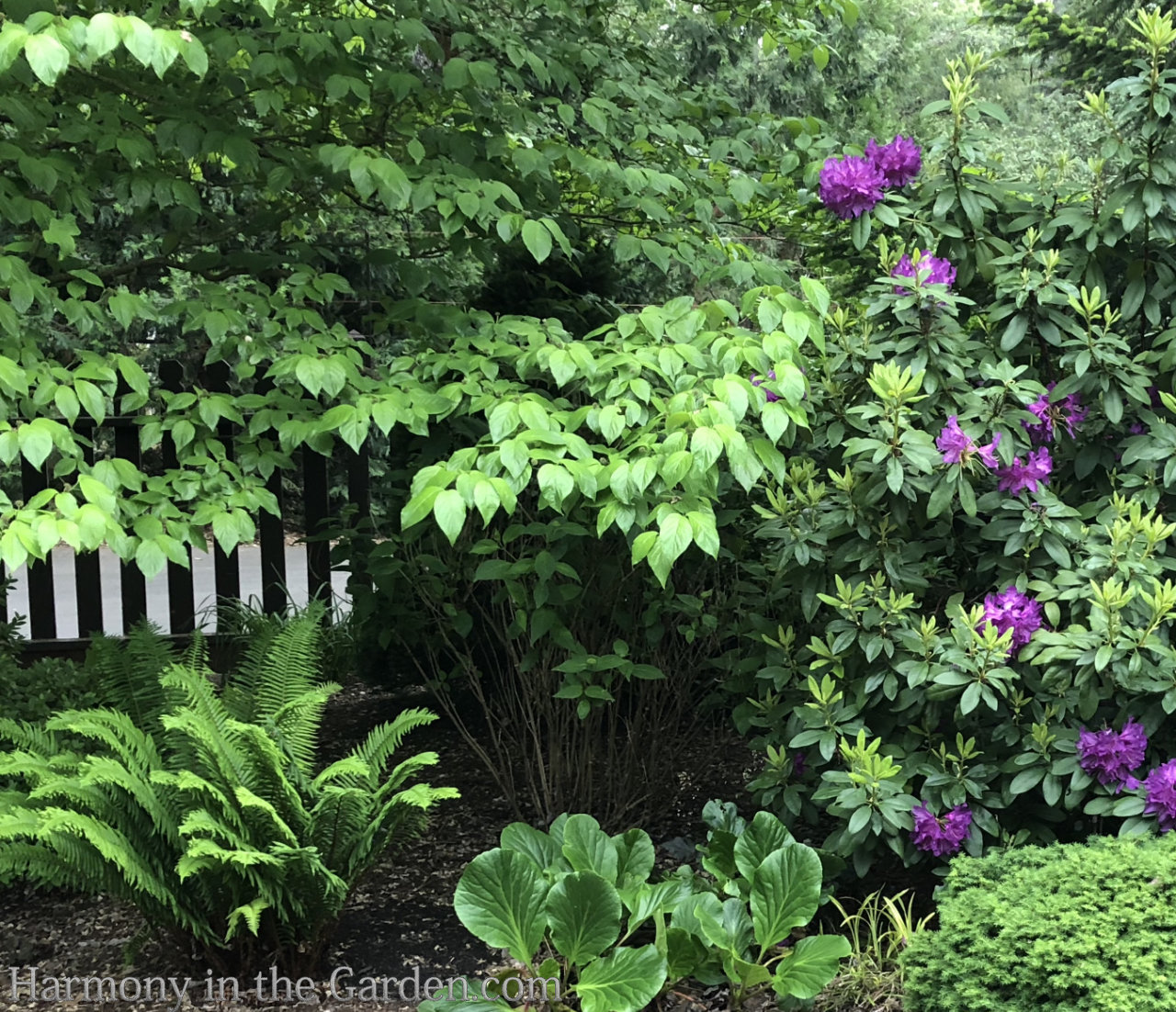
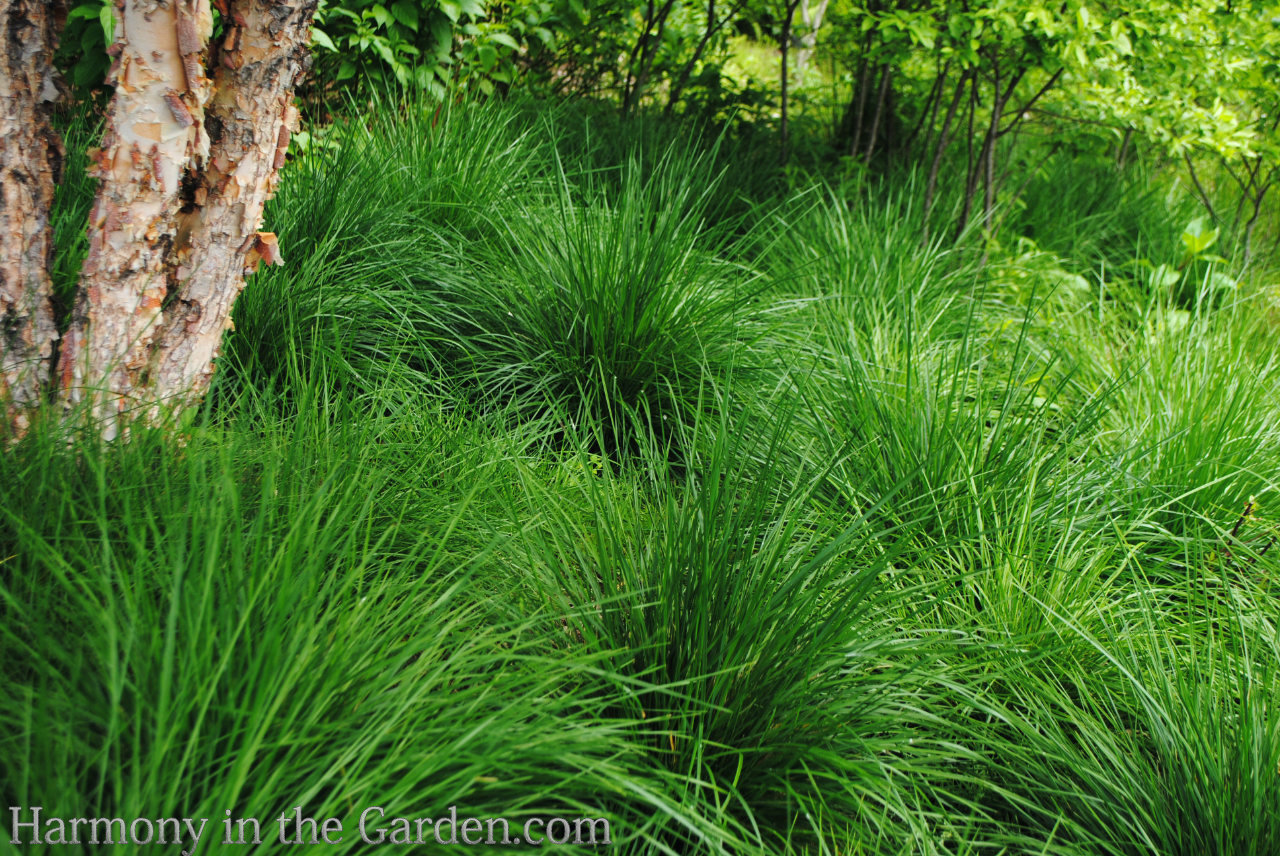
Grasses are fantastic to plant around tree roots as they’re often available in 4″ pots or they may re-seed, allowing you transplant them.
Deschampsia cespitosa (Tufted Hairgrass), left, requires a bit more water than my garden has to offer, but the below grasses are much more drought-tolerant.



I hope you’ve enjoyed this post and that it’s given you some hope in what to plant in this very challenging situation.
I thought I’d share with you what inspired me to write this post in the first place.
A few weeks ago, my friend gave me this vintage Sunset magazine, almost 75 years old!
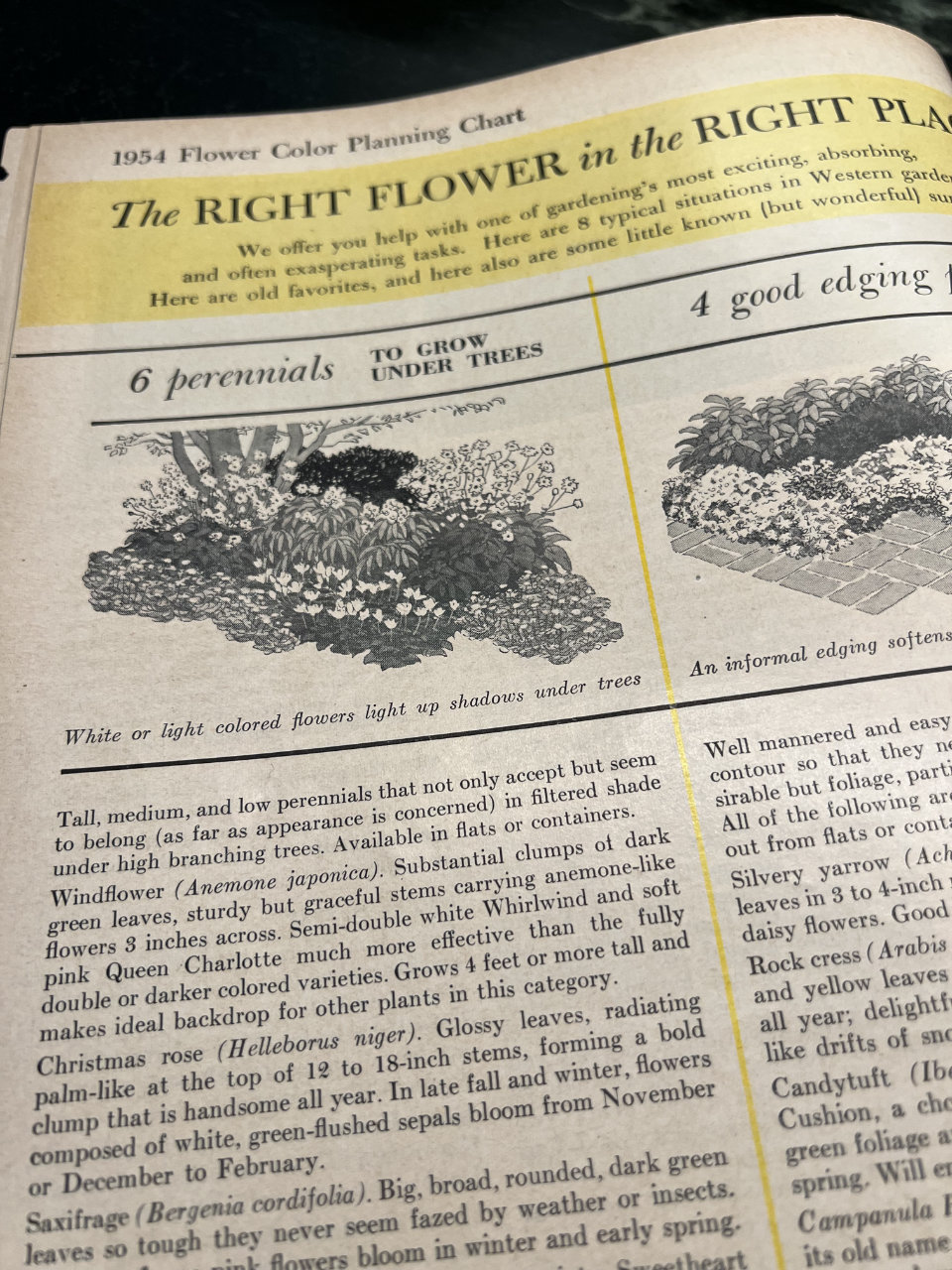
It’s amazing how the gardening-related articles seem as though they could’ve been written yesterday, in fact.
Well, except for all the ads and recommendations to buy every pesticide under the sun to blast the life out of all those ‘pesky insects’ (thank heavens we’ve moved beyond that!)
Even the title of the article, ‘The Right Flower in the Right Place’, is as popular now as ever.
But, if you look at the first section covered, it talks about what to grow under trees – hence, my inspiration.
Thanks, Sunset!






28 Comments
Great, informative article! I live in Idaho & have a large vegetable garden and a third of it is raspberries. The trees surrounding this 30’ X 35’ garden are huge maple & oak trees. The amount of daily sunshine diminishes yearly and the plants are producing less. I am tempted to remove the trees to save the garden but wonder if the roots would continue to suck up sll the nutrients after cutting down the trees. Your thoughts please!
Hi Alana – If you remove the trees by just cutting them off at ground level, in my own experience (I’ve had lots of oaks on my property fall) they’ll fairly quickly sprout a million branches in an effort to re-grow and therefore continue to suck up the nutrients in their root zone. Mine are live oaks, and since I’m not sure which varieties yours are, same with the maple, I’m not sure if they’d be thoroughly killed. A root grinder will take care of the job, though, making sure the trees won’t come back. Seeing as oak trees are such amazing native trees and a huge, valuable pollinator resource, maybe you could start small and only remove a couple of trees to see if that’s enough to let in ample sunshine?
Hi Rebecca! Great article! I have an approx 40 year old red oak in my yard with a huge drip line. I’ve recently pulled our front flower bed out past the tree and planted a few 4-6in ground covers / perennials throughout including creeping Jenny, creeping phlox, sweet woodruff and a bit of vina minor towards the back. Your sharpie pen analogy was a great visual for me during this process. I’m a little worried still about hurting the tree with the addition of soil and having to water that area for a while. This bed expansion involved digging up lawn in front of the tree, so telling myself it’s not any more than was there before with the lawn. Any recommendations or thoughts (or encouragement?)?
Hi Kelly, I’m so glad the article helped and am especially happy to hear you’re being so cautious around your oak tree. You’re right to be very careful as oak trees have pretty exacting requirements when it comes to watering. Without seeing everything in person, not to mention knowing more details about your site, I’d say you’re probably going about this the right way using a lot of caution with where you dig, being mindful of the roots, and careful with the watering. Since your groundcovers don’t have deep roots, the extra water they require right now is just a bit (versus having to water a deep-rooted perennial), so I don’t think adding a bit of extra water to get them established will harm your tree. You might buy an inexpensive water meter (the kind people use for houseplants) and stick it in the ground in various spots of your new bed to see just how wet or dry it is. I use these water meters ALL the time in the garden as they’ll let you know if your plant’s roots are getting enough water (much more accurate than just sticking your finger in the soil!) Best of luck!
Hi Rebecca,
I stumbled across this article and I’m so glad I did! Your insight is invaluable.
I just moved into a new home and have three large trees approx 15-20 ft. next to each other. I think they are maple but haven’t figured out which kind of maple yet. However, their drip lines touch and just barely overlap. Is there a possibility of planting a 1 gallon at the meeting point of their drip line? Is it safer to go with a ground cover in this case?
Thanks in advance!
Hi Jillian, welcome to my blog! Without seeing the area in person, I’d say to go ahead and try to plant the 1-gallon if you’re able to dig a large enough hole without damaging thicker tree roots. I’m not sure if the tree roots are deep, or surface-level which would make it difficult to plant anything other than a 4″ pot/groundcover. Good luck with your new garden!
I’m new to landscaping and gardening, so this was so helpful! How far apart do you plant the little plugs? I want to do a few different ones around our tree, but not sure how far to space them out. Will it just look weird for a while until the spread?
Hi Brianne, it really depends on what plants you’re using – check the tags to see what their ultimate spread will be and plant them far enough apart so when they’re fully grown they’ll ‘kiss’ not ‘tackle’! Yes, it’ll look a little sparse at first, but give the little plants time and they’ll fill in for you. If you plant too close, you might just have to carefully dig them up and move them to a better spot (and visa versa.) Good luck!
Loved this article and the links and I laughed when I read the Centranthus suggestion! It is trying to take over my garden.
What do you think about Francoa ramosa? I think I’m growing some that you gave to the old historical garden in Monterey. It is doing great under my Quercus agrifolia. I’m hoping it will spread.
Time-saving technology may well be the undoing of us. Keep forging forward.
Love to you and Tom.
Hi Sharon, Francoa is a great idea as it’s shallow-rooted and fairly low-water. Perfect! I have a wonderful patch of it directly under the one tree limb that can support my bird feeders. Which means the white-crowned sparrows and towhees scratch and scratch at the ground, shredding my poor plant. The obvious thing to do would be to move it or the bird feeders, but when it finally blooms (amidst its ragged leaves) it’s so pretty I just can’t bear it. Sorry about the boring story – ha! I love seeing your daily videos, makes me think I’m there in your garden with you! Big hugs to you and Jeff
Hi Rebecca – I gave the Horticultural report to the Atherton Garden Guild this AM – You have spoken to our group. Several of the ladies wamted your contact information but apparently you don’t have an e-mail. This article about tree roots was especially pertinant to our group so i would like to pass on some of the tips.
Is there a way to do this? I could of course, print this all out – do you charge for this? Thanks, Nan Ray
Hi Nan, I’m so glad you enjoyed my post and you’re welcome to pass along some of my tips. I don’t print my email, but instead have my ‘contact me’ page only because otherwise it gets picked up by spam. But it’s ‘my first name’ ‘at’ harmonyinthegarden dot com. I hope you and your group are hanging in there with all this rain! I vowed not to complain about this much-needed rain, but all at once? 😉
Great, very informative article. However, unfortunately a few of my trees have a very thick, well established mat of weeds and weedy grasses growing all the way up to the trunk. How do I go about clearing these, which are some of the most persistent types of weeds, with very aggressive runners?
Hi Lela, I’m so sorry you have such terrible thick mats of weeds. Those are a nightmare, for sure. Personally, I don’t like to use round-up in my gardens, but I know sometimes that (or something equally as powerful) is what’s needed. Of course, using it around tree roots is incredibly dangerous for the tree, but I’ve known some people to ‘paint on’ the poison with a brush, which allows it to only touch the weeds and nothing surrounding the weeds. But then, the poison travels down the weed roots and into the soil, which is at the crux of the problem with those herbicides. If it were my garden, I would try and try to be consistent and pull the weeds, removing every single piece of root that I could find. Sometimes it takes several weed ‘generations’ (which can be several in a single year) until you get the upper hand, but after a few years you should see progress. I wish you luck!
Hi Rebecca
Just finished planting some bulbs, however, your article makes me think I forgot other bulbs. I will check Annie’s Annuals & Perennials catalog. There is no end to what I can do in the garden.
Barry Friesen of Dawn Landscaping, is opening his garden, March 18th from 9 AM – 5PM, at 14446 Perimeter Road, Grass Valley, CA 95949. His phone: 510-385-5139. He has a sea of daffodils. He also introduced me to Chinese Houses seeds, which I love to plant every year.
Must say, love seeing your name appear on my computer!
Wow, thanks for the tip about the open garden, Judy. I’m so sad, though, because we’re heading out of town that weekend 🙁 However, if Tahoe gets yet another big snowstorm, then we’ll stay here and I’ll definitely go up there. Annie’s is the ideal place to look for 4″ pots for underneath trees. I was just there a few weekends ago and couldn’t believe how many things they had already (even though they’re small, they’re still awesome!)
Barry Friesen, worked mainly in San Francisco. He is a sweetheart and is, like you, buckets full of knowledge and will share information freely.
Thanks for the article. I have a question I live near the ocean in Massachusetts.
My weeping cherry tree had some exposed roots that I kept trying to cover with soil. What did was put small rocks that I collected from the beach around the bottom of the tree. Now I am concerned that I might be killing my beautiful Cherry tree. What do you think?
Hi Pat, without seeing it in person I’m not entirely sure. However, after doing a google search on a cherry tree’s roots, it seems they’re pretty darn tough. If they’re big enough (and the tree old enough) I wouldn’t think a few ornamental rocks would hurt it. Covering all the roots with 8″ of soil, however, is a different story. You might see if an arborist can come out to take a look? Here’s the article I found that talks about their roots – maybe it’ll help a bit? https://rennieorchards.com/are-cherry-roots-invasive/
Thanks for the article. I have a question I live near the ocean in Massachusetts.
My weeping cherry tree had some exposed roots that I kept trying to cover with soil. What did was put small rocks that I collected from the beach around the bottom of the tree. Now I am concerned that I might be killing my beautiful Cherry tree. What do you think?
Wonderful info for planting around trees. I especially appreciate your emphasis on precautions to maintain tree health and the inclusion of native plants. The old Sunset magazine you featured brings back wistful memories of Sunset’s former headquarters in Menlo Park and their open houses. It was a sad day when they moved to Sonoma County. Still, I have my Mom’s original Sunset Gardening book from the 50s!!
Hi Ronnie, thanks so much for your compliments, I appreciate that. I miss the old Sunset, also. Wasn’t it wonderful? Ahhh….at least we got to be part of it, right? I hope your garden is enjoying this rain as much as mine is – I can almost hear it breathing a huge sigh of relief! Happy Gardening 🙂
Do you think a Shooting Star Lily (Antherimum) would work around a crepe mrytle?
Hi Nancy, I’m not sure with Antherimum as I don’t have experience planting them outside (we’re much too cold here.) I did a quick google search and came up with this (which makes me think that the answer is probably ‘not really’) https://www.thespruce.com/grow-anthurium-plants-1902738
Hi Rebecca,
Another great informative article! I have great success with cyclamen coum, geranium Bio Kovo, ajuga, creeping raspberry and Bergenia crassifolia. Thinking of trying some of your suggestions….and yes I do not plant at the base of oak trees.
Thanks so much, Sabrina. You and Freeland are experts at planting under trees (and everywhere else for that matter!) Hope all is well with you two. Aren’t our gardens lucky to receive this much rain!?!!!! Should be a glorious spring!
Hi! Thank you for this article!
FYI:
The link in your recent newsletter to this blog isn’t working.
Thanks, Patty – as it typical of this past month, it’s one glitch after another (UGH!) Thanks for the heads-up 🙂